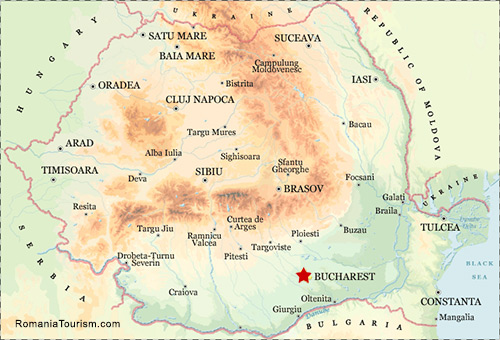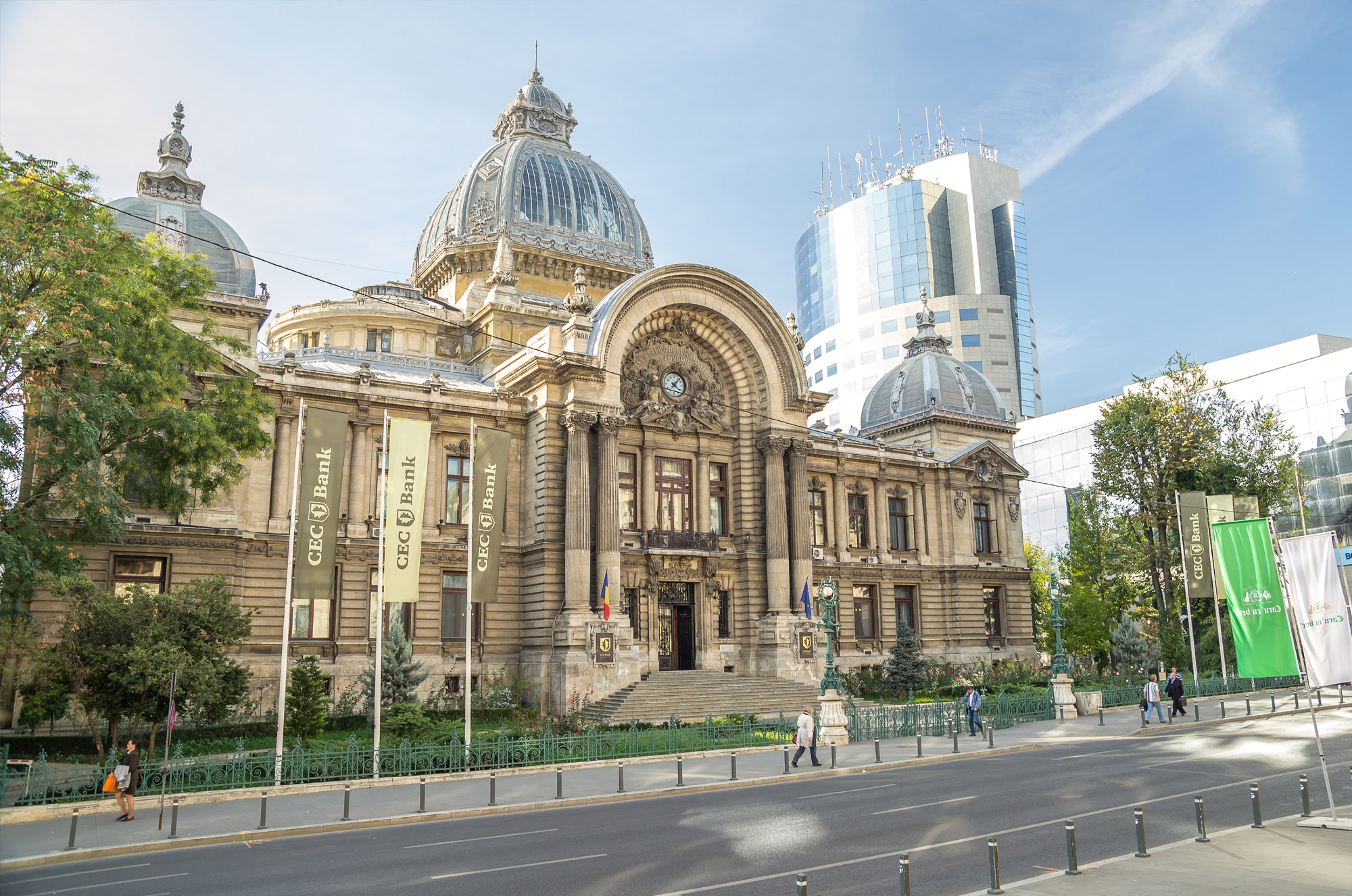
Bucharest Fast Facts
Name: București (pronounced Boo koo reshte' )
Location: Southern Romania
Elevation: 190 - 295 ft. (55 - 90 m)
Area: 88 sq.miles (228 sq.km);
Metropolitan area: 590 sq.miles (1,530 sq.km)
First documented: 1459 AD
Capital city since: 1659
Population: 2.1 million
...
Known for its wide, tree-lined boulevards, glorious Belle Époque buildings and a reputation for the high life (which in the early 1900s earned its nickname of "Little Paris"), Bucharest, Romania's largest city and capital, is today a bustling metropolis. Legend has it that the city of Bucharest was founded by a shepherd named Bucur, whose name literarily means "joy." His flute playing reportedly dazzled the people and his hearty wine from nearby vineyards endeared him to the local traders, who gave his name to the place.
SpotlightSojourns:
The words of 19th-century French geographer Jacques Élisée Reclus apply, again, to Bucharest today:
“Bucharest has been transformed rapidly with the increasing wealth of its inhabitants …
[and] fully deserves now its sobriquet of the “joyful city.” (1883)
Journalist Angus Begg:
This storied city of pain and creativity in a fabled landscape of cosmopolitan influence
has been shouting loud at me from the moment we circled the 1930s Arcul de Triumf (Arch of Triumph),
the symbol of both Romania's victory in the First World War and its unity
(a bang-on replica of the Paris original).
Stained beauty threads its way through this leafy city.
Orthodox churches rub shoulders with monolithic communist drudge,
French-inspired mansions and apartments and art deco survivors of dictator Nicolae Ceauşescu's deeply disturbing rule.
And there's still room for Bucharest's delightfully wide boulevards,
lush urban parks, an Armenian cathedral and University square,
along with his parliament palace of 1,000 rooms and over 2,000 chandeliers.
The city breathes creativity and history, from Saxons to Ottomans.
It speaks a Latin Romance language, explaining the often Italian lilt to their conversations (and similar words).
Can't wait to be back.
...
Bucharest Sights and Landmarks
Arch of TriumphArcul de Triumf
Address: Piata Arcul de Triumf
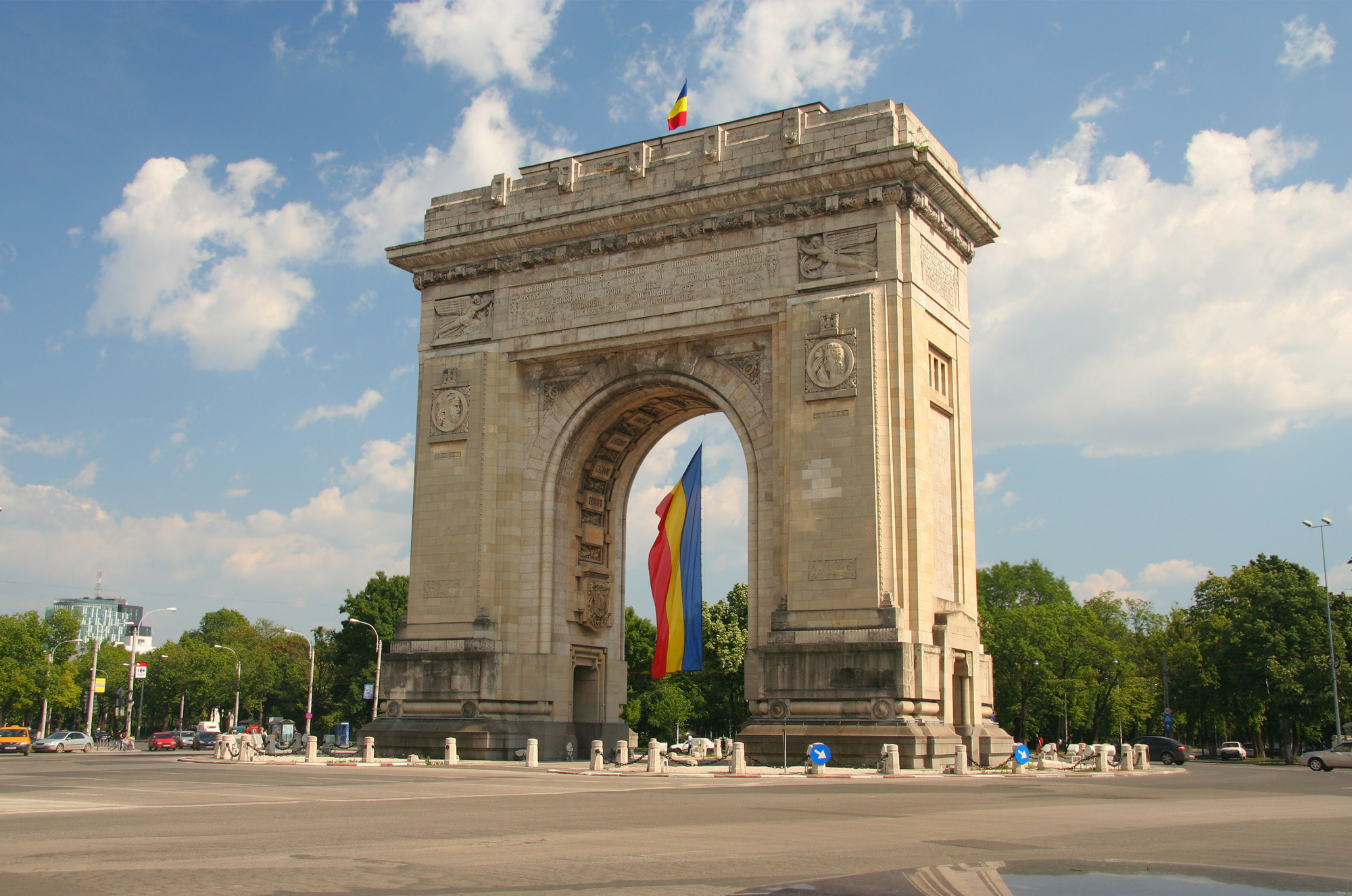
Built in 1922 to honor the Romanian soldiers who fought WWI, Bucharest's Arch of Triumph also symbolizes Romania's latin heritage and its strong ties with France. The monument was redecorated in 1936 with base-reliefs carved in marble brought from Rușchița - Transylvania. The sculptures were created by leading Romanian artists - including Ion Jalea, Constantin Medrea and Constantin Baraschi - and ten Italian sculptors. Every weekend, June through October, visitors can climb to the top of the 90 feet-high structure, via an interior staircase, for a panoramic view of the city.
Day-trip to Peles castle, Bran castle and Old Town BrasovItinerary: Bucharest — Sinaia — Bran — Brașov — Bucharest
More information and reservations Calea Victoriei
Calea Victoriei (Victory Way) is Bucharest's oldest and arguably, most charming main street.
Designed in 1692 to connect the Old Princely Court to Mogosoaia Palace, Calea Victoriei (initially named Podul Mogoșoaiei) was originally paved with oak beams. In 1878, the street was renamed Calea Victoriei, to mark Romania's victory in its Independence War against the Ottoman Empire.
In early 1920's, Calea Victoriei became one of the most fashionable, vivid, streets in the city.
Stroll along Calea Victoriei starting at Piata Victoriei and go on till its end at Piata Natiunilor Unite.
Stunning buildings line Calea Victoriei, including the Cantacuzino Palace, the former Headquarters of the Romanian Communist Party,
the Military Club, the Palace of the Savings Bank and the National History Museum.
Cantacuzino Palace
Palatul Cantacuzino
Address: Calea Victoriei 141
Curently closed to visitors, ample preservation works in progress,
The former residence of Grigore Cantacuzino (nicknamed Nababul - the Nabab) is one of the most beautiful structures that line Calea Victoriei. A member of Cantacuzino princely family, former mayor of Bucharest, minister and Prime Minister, Grigore Cantacuzino was considered, in late 1800s, to be one of the wealthiest Romanians.
His desire to have the most elegant residence in all Bucharest became a reality in 1902. This beautiful Beaux Arts palace, designed by architect Ion Berindey, features superb wrought iron balconies, tall arched windows and a porte-cochere flanked by two lions.
Today, the palace houses the George Enescu Museum, dedicated to one of Romania's greatest musicians.
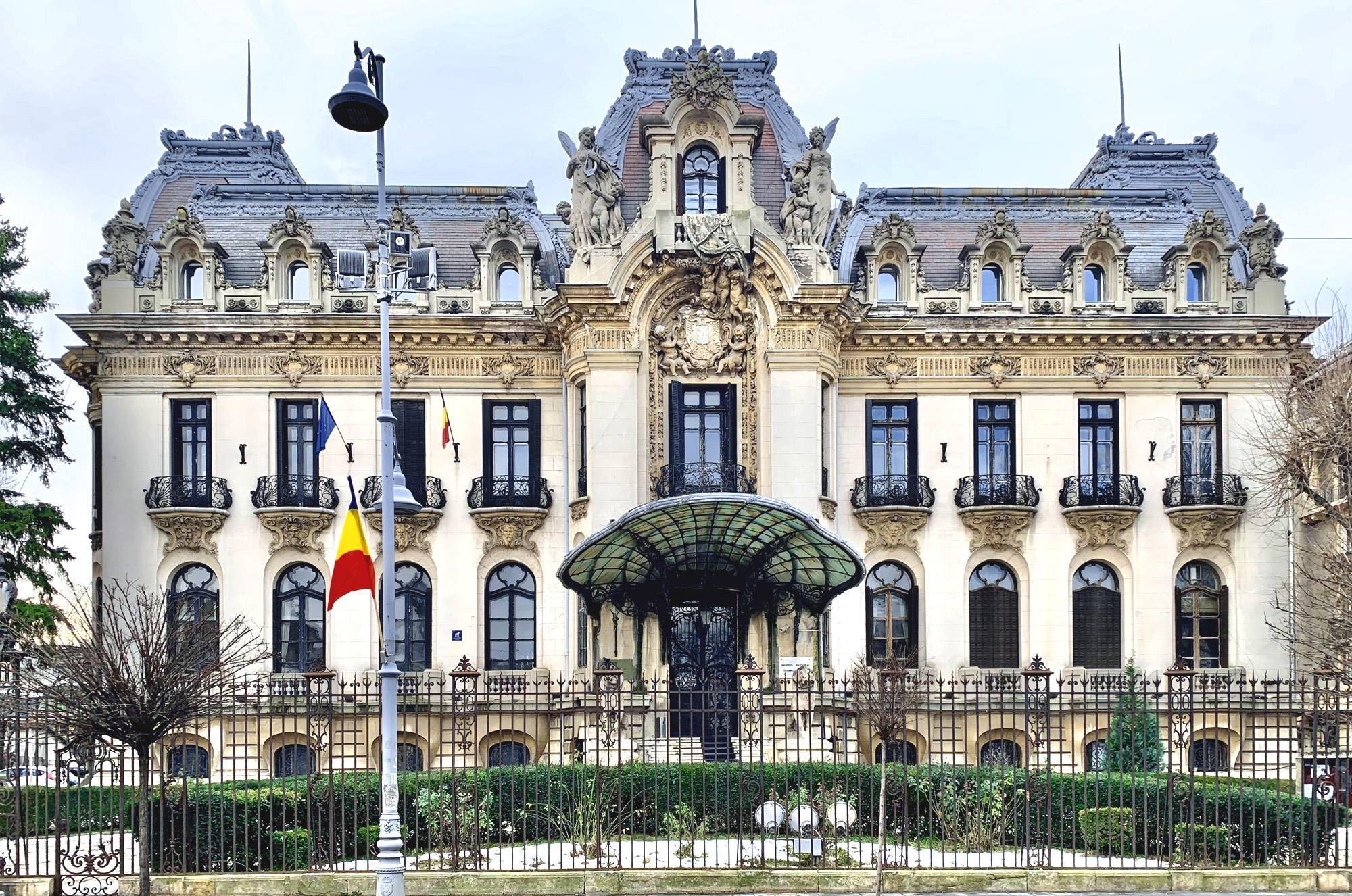
Piata Revolutiei
One of Bucharest's ares most often associated with the 1989 unrest that lead to the demise of Romania's Communist Regime is Piata Revolutiei.
Revolution Square gained international notoriety when TV stations around the globe broadcasted
Romania's Communist leader Nicolae Ceausescu's final moments in power, on December 21, 1989.
From the balcony of the former Communist Party Headquarters, Nicolae Ceausescu stared in disbelief
as the people gathered in the square, as his request, turned on him. He fled the angry crowd in his helicopter and his 34-years in power ended.
Revolution square's importance stretches back long before the dramatic events of the 1989 Revolution.
On the west side of the square stands the former Royal Palace, now home to the National Art Museum
and the small, but beautiful, Kretzulescu Church. On the opposite side of the Royal Palace stands the stunning Romanian Athenaeum,
an 1,000-seat music venue known for its excellent acoustics and huge frescoes that depict important moments in Romania's history.
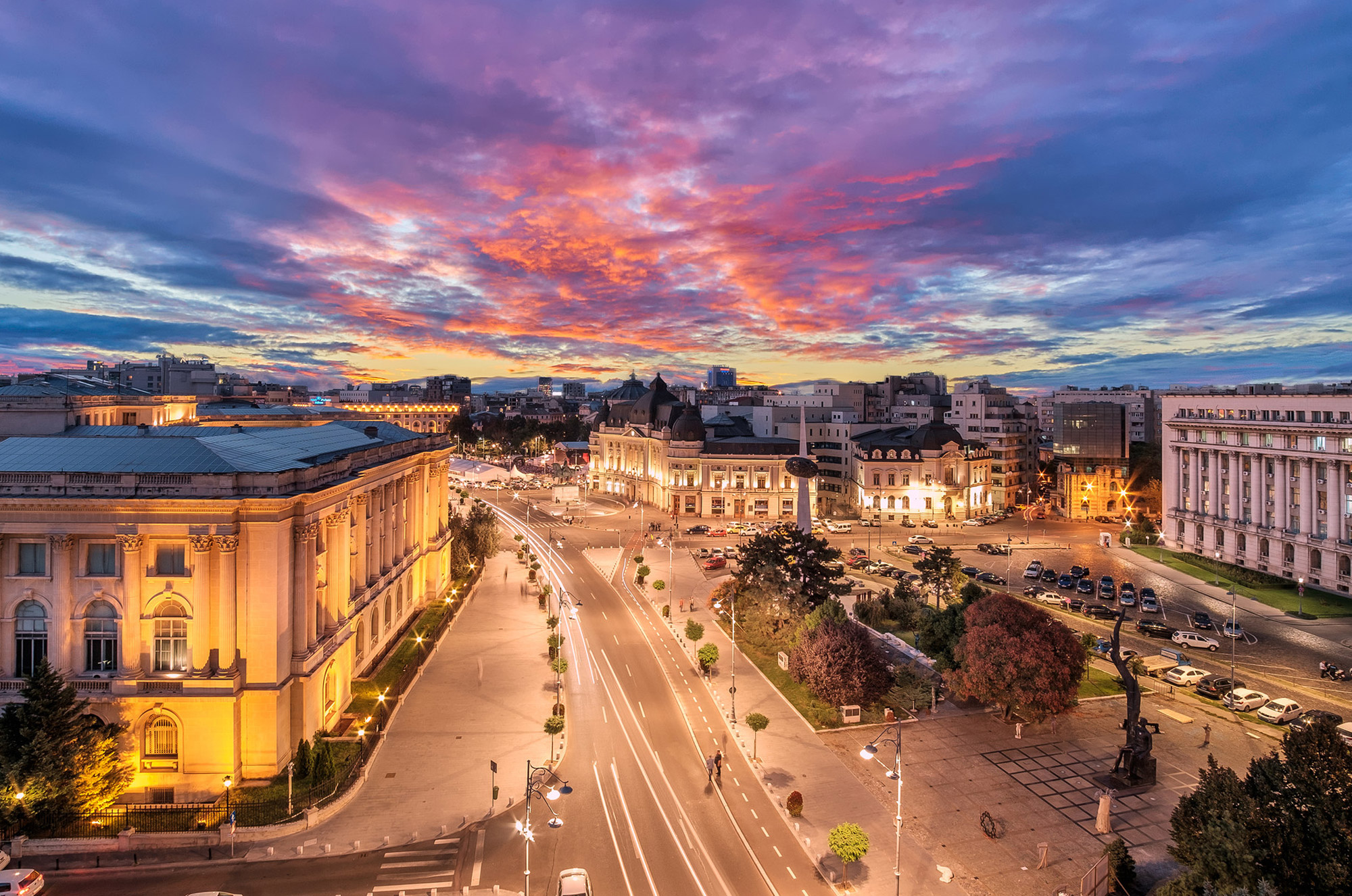
Palatul Regal
Address: Calea Victoriei 49 - 53
Completed in 1937, in neoclassical style, Bucharest Royal Palace was home to King Carol II and to his son,
King Mihai I, until 1947, when the monarchy was abolished in Romania. It was inside this palace that King Mihai, then aged 18,
led a coup that displaced the pro-Nazi government during the World War II and put Romania on the Allies' side.
Today, the former Royal palace houses Romania's National Art Museum.
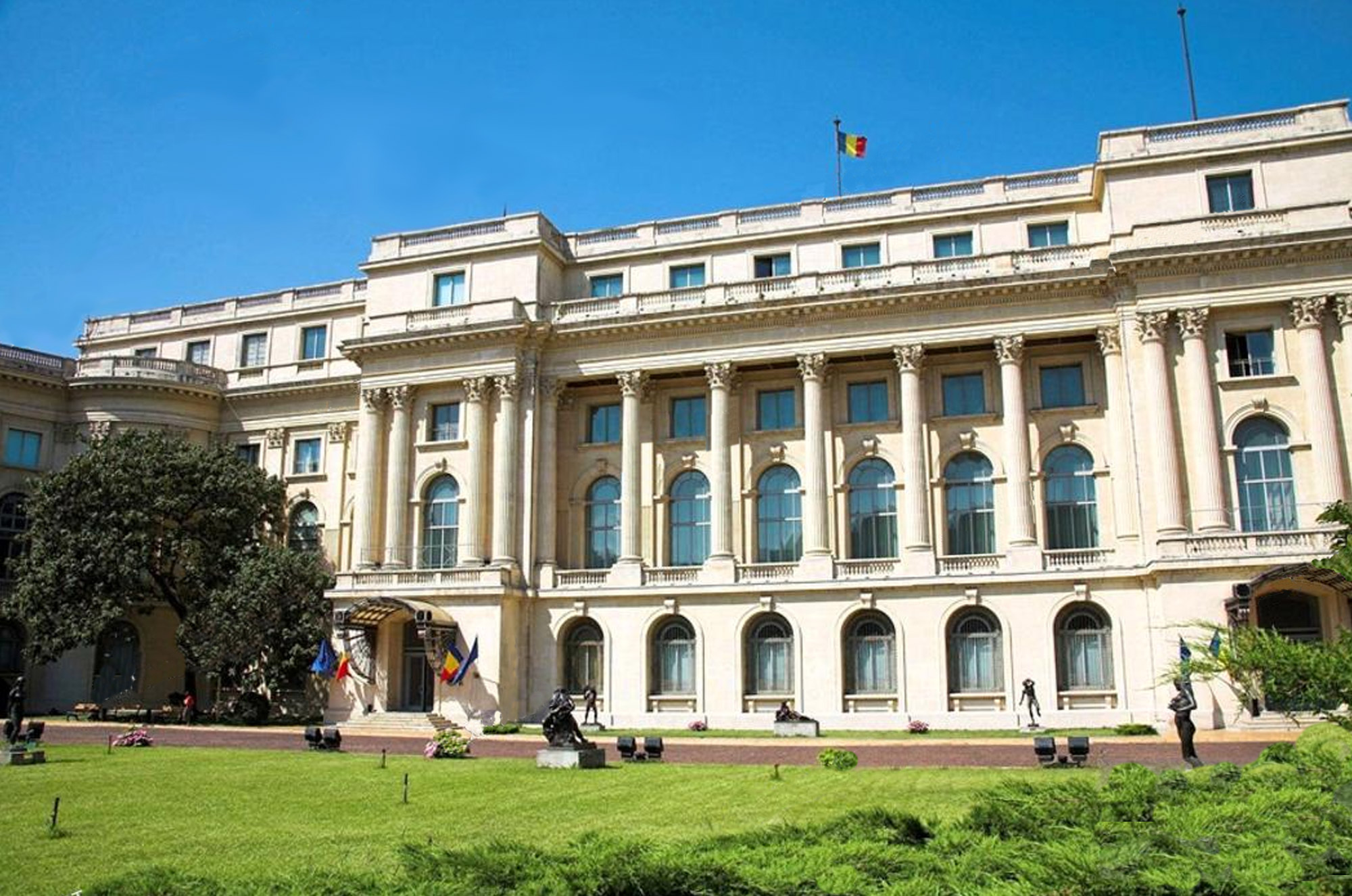
The Romanian Athenaeum
Atheneul Roman
Address: Strada Benjamin Franklin 1
Tel: (+4) 021 315.00.26
The Romanian Athenauem - an European Heritage building - was designed by French architect Albert Galleron,
who also designed the National Bank of Romania.
The construction of the Athenaeum was initiated on February 25, 1873 by the Romanian Athenaeum Society
(founded in 1865 by naturalist Constantin Esarcu, physician Nicolae Kretzulescu and historian V. A. Urechia);
it was largely financed with money donated by the general public,
thanks to a successful fundraising campaign "Dati un leu pentru Ateneu" (Donate a coin for the Athenaeum).
The Athenaeum was completed in 1888.
Its high dome and Doric columns resemble an ancient temple.
The lobby has a beautifully painted ceiling decorated in gold leaf,
while curved balconies cascade in ringlets off a spiral staircase.
A ring of pink marble columns is linked by flowing arches where elaborate brass lanterns hang like gems from a necklace.
A spectacular fresco, by Painter Costin Petrescu, adorns the concert hall;
it depicts 25 historical events concerning Romania’s national identity and pride.
Renowned worldwide for its outstanding acoustics, Romania's most prestigious concert hall - and home of the Romanian Philharmonic Orchestra -
is open to visitors.
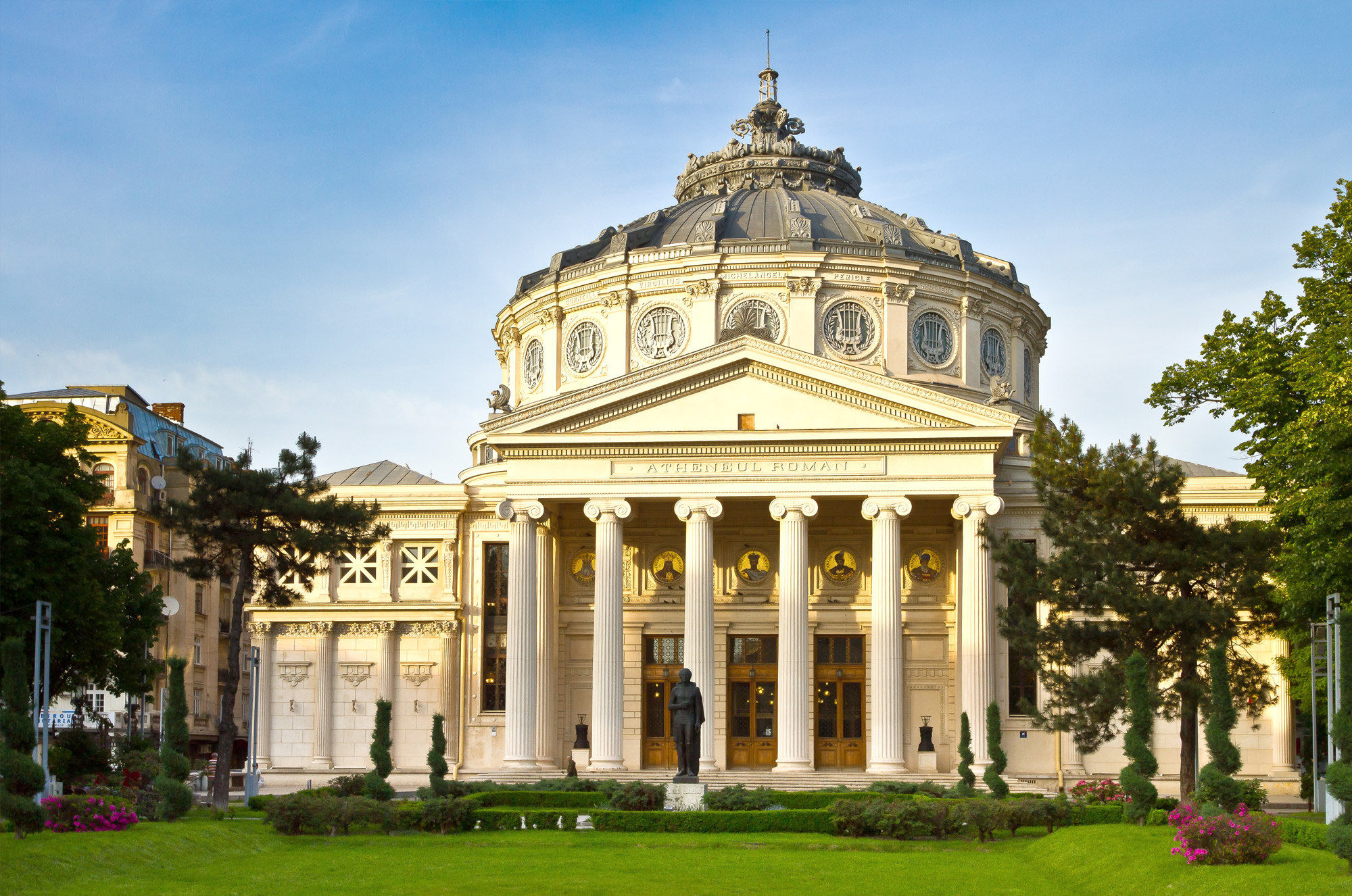
Biserica Cretulescu
Address: Calea Victoriei 47
Nestled amid the other historical buildings in Piata Revolutiei, this small red-brick Orthodox church was built in 1722 by the chancellor Iordache Kretzulescu and his wife, Safta (a daughter of prince Constantin Brancoveanu) in Brancovenesc architectural style.
The interior frescoes were executed around 1860 by painter Gheorghe Tattarescu.
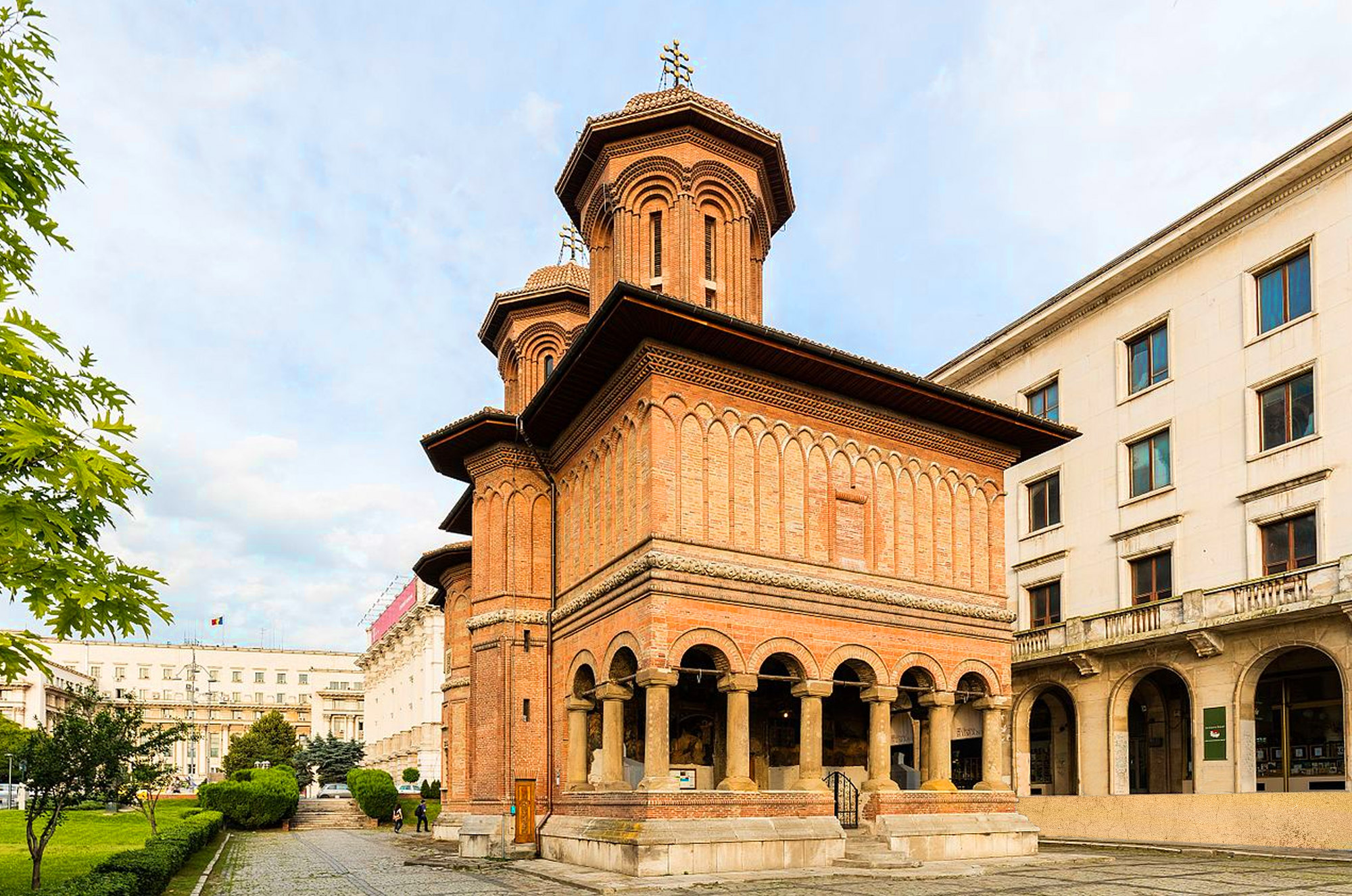
Sala Mare a Palatului
Address: Strada Ion Câmpineanu 28
Located next to the Royal Palace, the concave-roof structure was built in 1960 to accommodate the 3,000 Communist party members who every five years attended the communist party congress. It was on this stage that Nicolae Ceausescu would deliver his vision of a multilaterally developed socialist society. Today, the massive auditorium plays host to various conferences and events, including some of the George Enescu International Festival concerts.
Cercul Militar National (or Casa Armatei)
Address: Strada Constantin Mile 1
Tel: (+4) 021 313.86.80
This neoclassical masterpiece, designed by Romanian architect Dimitrie Maimaroiu, was built in 1912 to serve the social, cultural and educational needs of the Romanian army. Banquets and official events are still hosted in the ballrooms, while the upstairs area is reserved for the army's library, as well as offices and classrooms for officer instruction. The main part of the building is off-limits to civilians, but the sumptuous restaurant and summer terrace is open to the public.
Palatul CEC / Palatul Casei de Economii si Consemnatiuni
Address: Calea Victoriei 13
Boasting one of the most impressive neoclassical facades in the city,
this structure, designed by French architect Paul Gottereanu, was completed at the end of the 19th century.
The square-shaped palace, home of the first Romanian Savings Bank, has a large central glass dome, flanked by four smaller domes. The arch at the entrance, with its Corinthian columns, is a highlight of any architectural tour of the city.

Old Town Bucharest / Lipscani street Area
Centrul Vechi / strada Lipscani
At the beginning of 1400s, most merchants and craftsmen - Romanian, Austrian, Greek, Armenian and Jewish -
established their stores and shops in this section of the city;
a jumble of streets between Calea Victoriei, Blvd. Bratianu, Blvd. Regina Elisabeta and the Dambovita River.
Soon, the area became known as Lipscani, named for the many German traders from Lipsca or Leiptzig.
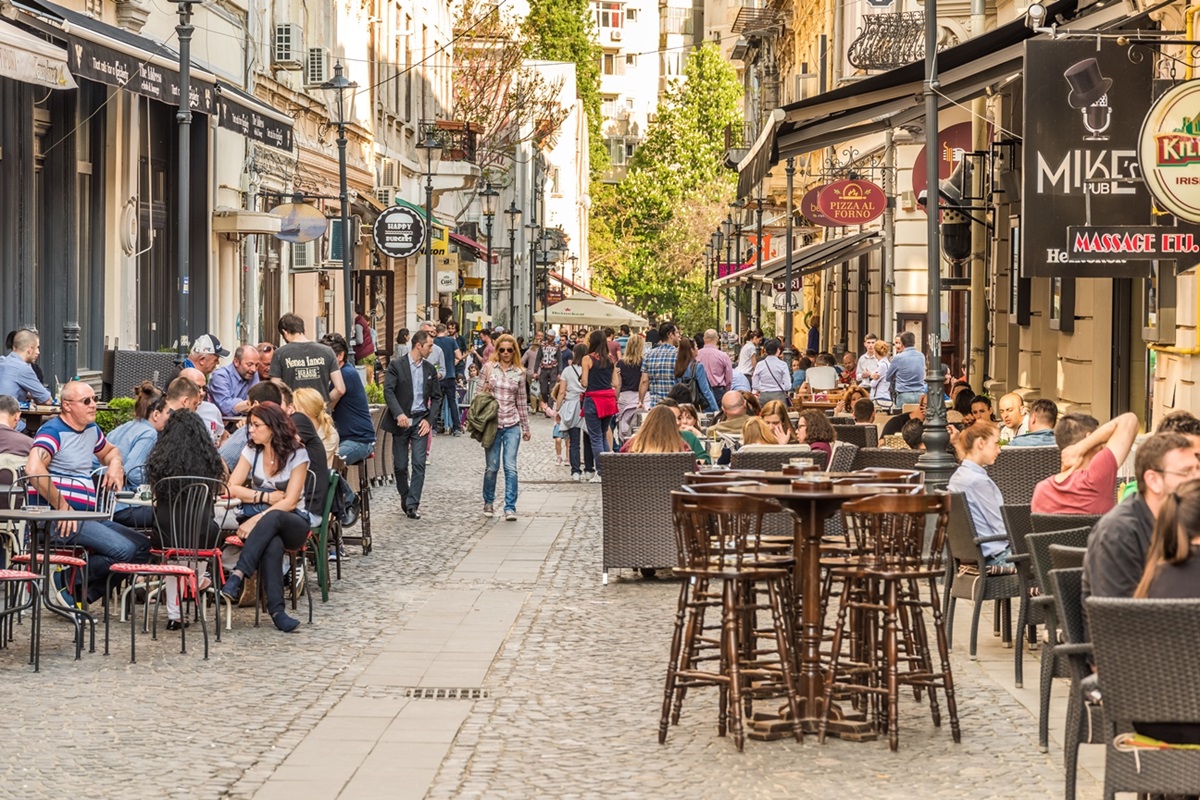
Other streets took on the names of various old craft communities and guilds, such as Blanari (furriers), Covaci (blacksmiths), Gabroveni (knife makers) and Cavafii Vechii (shoe-makers).
The mix of nationalities and cultures is reflected in the mishmash of architectural styles, from baroque to neoclassical to art nouveau.
Today, the area is home to art galleries, antique shops, coffeehouses, restaurants and night-clubs.
While walking in the narrow cobblestone streets one can imagine the long-gone shopkeepers outside near their stores, inviting bypassers to buy their merchandise.
Old Town Bucharest map
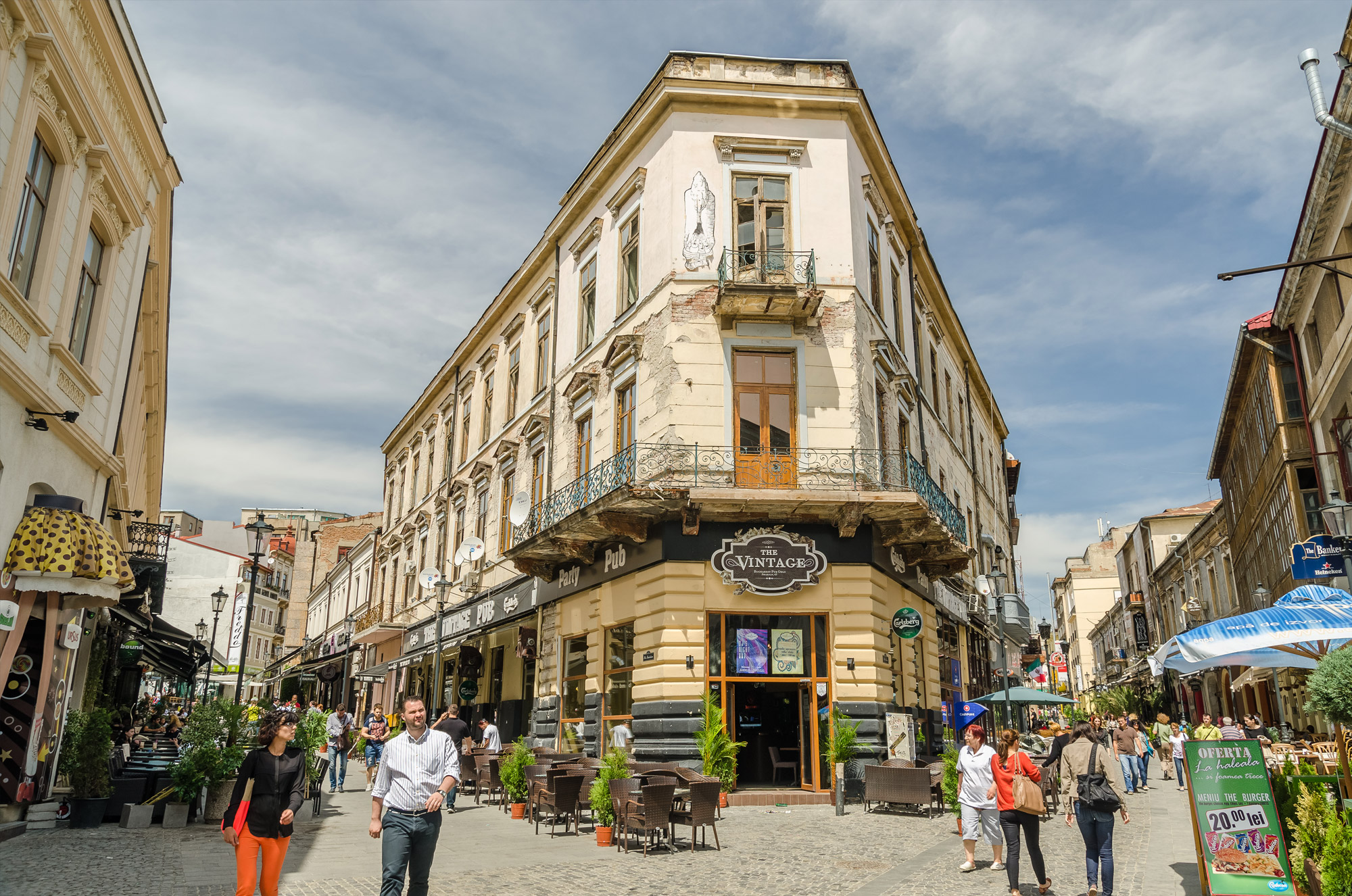
Old Princely Court
Palatul si Biserica Curtea Veche
Address: Strada Franceza 25 - 31
Currently closed for restoration works.
Telephone: (+4) 021 314.03.75
The remains of the Old Princely Court (Curtea Veche) - commissioned in the 15th century
by prince Vlad Tepes (or Vlad Draculea) - are located at southern edge of Bucharest Old Town.
Historians believe that, Vlad the Impaler kept his prisoners in dungeons which beneath his Princely Court.
The Old Court Museum was established in 1972 when an archaeological dig
revealed the remains of the fortress, walls, arches, tombstones and a Corinthian column
along with Dacian pottery and Roman coins and other evidence of Bucharest's earliest inhabitants.
The oldest document attesting to the city's origin under the name of Bucuresti (Bucharest) was discovered here also;
it was issued on September 20, 1459 and signed by Prince Vlad Tepes.
Next to Bucharest Old Princely Court stands the Old Court Church (Biserica Curtea Veche),
dating from 1559 - considered the oldest in Bucharest. Some of the original 16th century frescoes have been preserved.
For two centuries, the church served as coronation venue for Romanian princes.
Hanul lui Manuc
Address: Strada Franceza 62 - 64
Tel: (+4) 021 313.14.11
Built in 1804 at the request of wealthy Armenian trader Emanuel Marzaian (called by the Turks "Manuc Bey"),
the inn hosted the preliminary talks concerning the Peace Treaty that put an end to the Russian -Turkish War (1806-1812).
A favorite meeting place for tradesmen, Manuc's Inn has preserved to this day its character and flavor.
A restaurant, wine cellar and a pastry shop are now welcoming guests from all over the world.
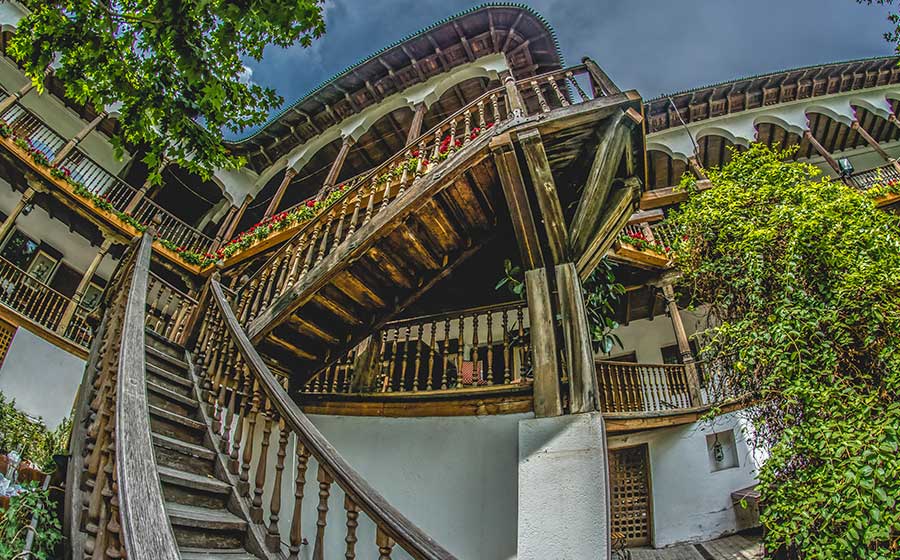
The Beer Wagon Restaurant
Carul cu Bere
Address: Strada Stavropoleos 3 - 5
Tel: (+4) 021 313.75.60
The Beer Wagon restaurant/ beer house became, soon after the opening in 1879, one of the most popular meeting places for Bucharest's literati
who would gather to discuss matters of their time. Its neo-gothic architectural style is reflected both in the façades
and the interior decorations: columns, arches, chandeliers, a wooden staircase, furniture and murals on the walls and ceiling.
Banca Nationala a Romaniei
Address: Strada Lipscani 25
The National Bank of Romania (BNR) stands on the site of, well-known at its time, inn (Hanul Serban Voda), open in 1678.
Two fires gutted the building and in 1883 the land was leveled and work to build a home for Romania's National Bank begun.
The new structure, designed by French architects Cassien Bernard and Albert Galleron, was completed in 1885.
The neoclassical French-style structure boasts a facade with Corinthian columns and an enormous central hall.
Duration: 90 minutes.
Start hours: 12 p.m. and 4 p.m. (English-speaking guide) and 10 a.m., 12 p.m., 2 p.m. and 4 p.m. (Romanian-speaking guide)
Appointment, at least two working days before visit, is mandatory.
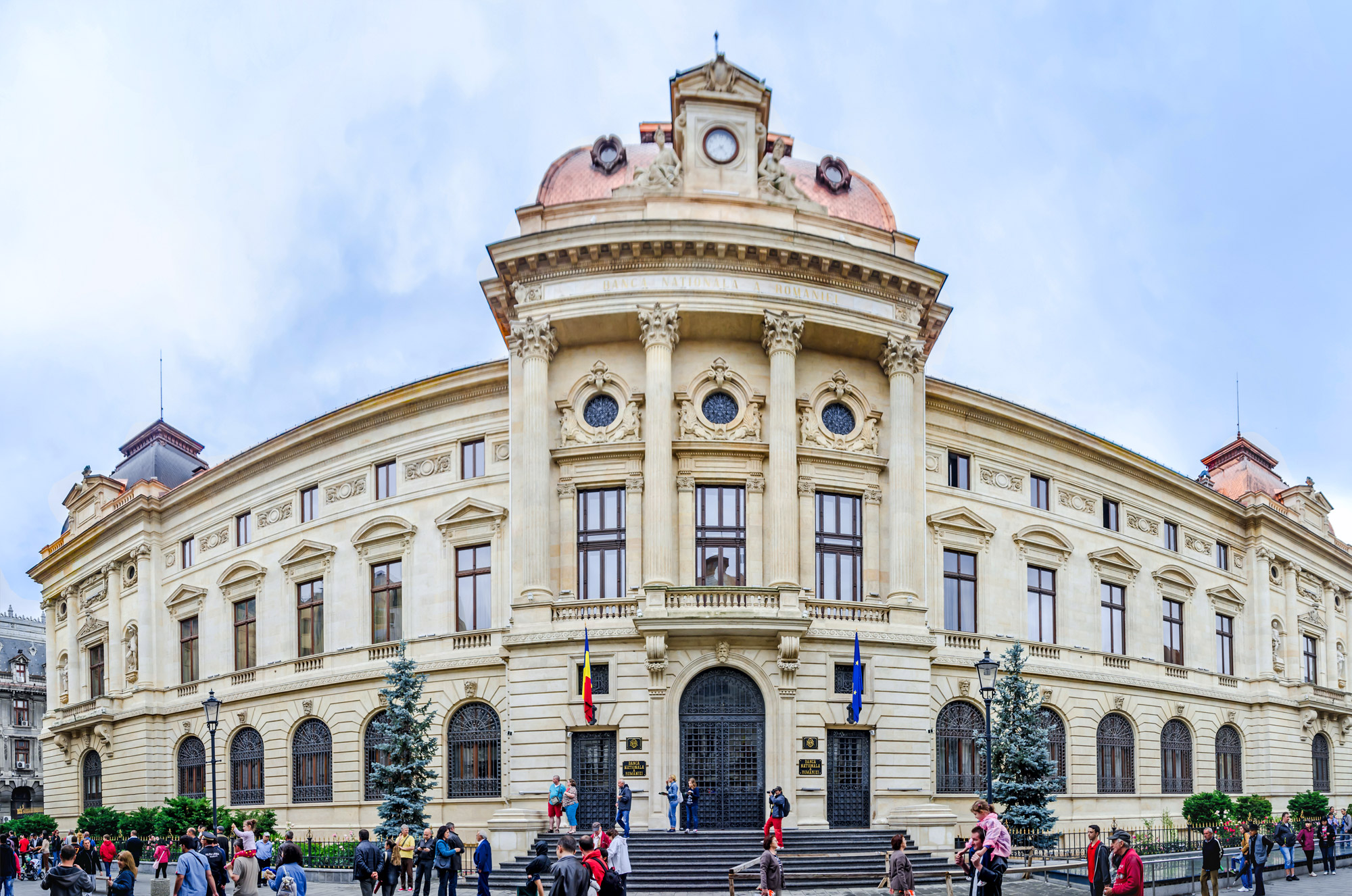
Piata Universitatii
Buzzing with crowds and traffic from early morning until late at night, this area is one of the most popular meeting places in Bucharest.
The square features remarkable architecture: Bucharest School of Architecture, the National Theatre,
the neoclassical Coltea Hospital and its lovely church (1702 - 1794) and Sutu Palace,
now home to the Bucharest History & Art Museum.
In the middle of the circle, on a little 'island', 10 stone crosses pay respect to those killed during the 1989 revolution.
Below the circle there is an underground passage, with small shops, that offer pedestrians access to the one side of the circle
and to University Circle (Piata Universitatii) subway station.
Universitatea Bucuresti
Address: Blvd. Regina Elizabeta / University Circle
Bucharest is Romania's largest and foremost centre of higher education. The University of Bucharest was founded in 1864 by prince Alexandru Ioan Cuza, ruler of the newly united principalities of Walachia and Moldova. The home of the university is a neoclassical building (completed in 1859) located in the heart of Romania's capital city.
In the small square next to the University building book merchants are offering anything from antique books to vinyl records,
discontinued newspapers and illustrated broadsheets from another age.
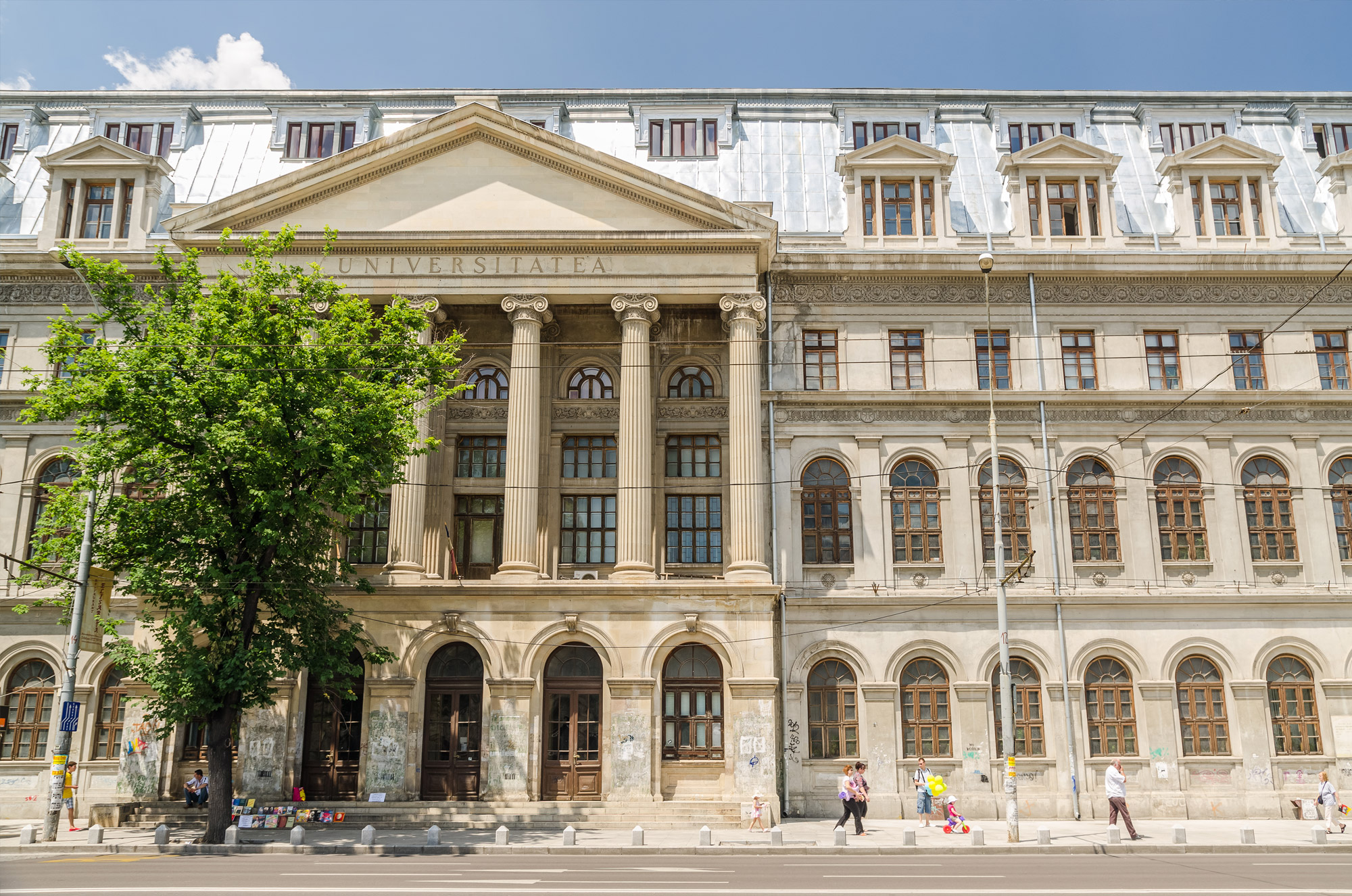
Casa Presei Libere
Address: Piata Presei Libere 1
A masive edifice standing in the northern part of Bucharest, since 1956, Casa Scanteii (as it is still universally known)
was designed by architect Horia Maicu. The building is a smaller replica of the Lomonosov University in Moscow - Russia.
Between 1956 and 1989, the House of the Free Press housed almost all of Romania's capital printing presses and headquarters of print media companies.
Today, Casa Presei Libere carries out much the same function but the southern wing is now the home of the Bucharest Stock Exchange.
Spitalul Coltea
Address: Blvd. I.C. Bratianu 1
The oldest hospital in Bucharest, dating from 1704,
Coltea was built on land belonging to Vacaresti family, who at the time owned many great properities in the capital.
The original building was destroyed by an earthquake in 1802 and replaced by a neoclassical building still standing today.
Next to the hospital stands a church, built in 1701, known for its its spectacular murals.
Palatul Sutu
Address: Blvd. I. C. Bratianu 2
Famous for the grandiose balls held here in the early 1900s,
Sutu Palace was built in Neo-Gothic style between 1832 and 1834.
It was designed by architects Johann Veit and Konrad Schwinck
at the request of commissioned by foreign affairs minister Costache Sutu.
In 1862, the palace was redecorated by sculptor Karl Storck, who created three arcades and a monumental stairway;
a huge Murano mirror was added in the hallway. Only the painted ceilings, the stucco, the parquet flooring
and the tile stoves have been preserved.
In 1959, Sutu Palace became home to Bucharest History & Art Museum
Bucharest Communist legacy
Romania's Parliament Palace
Palatul Parlamentului
Address: Strada Izvor 2 - 4
Tel: (+4) 021 311.36.11
Open to visitors: Mon. - Sun.
Bucharest Palace of Parliament Hours and Admission
Built at the special request of Nicolae Ceausescu, leader of Romania's Communist Party,
the colossal Parliament Palace - formerly known as "People's House" ( Casa Poporului ) -
is the world's third-largest administrative building, after Surat Diamond Bourse (India) and U. S. Pentagon.
It took 20,000 workers and 700 architects to build this masive structure that boasts 12 stories above ground, 1,100 rooms,
a 350-ft.-long lobby and eight underground levels, including an enormous nuclear bunker.
The crystal chandelier in the Human Rights Hall (Sala Drepturilor Omului) weighs 2.5 tons.
Some of the chandeliers have as many as 7,000 light bulbs.
When construction started on June 25, 1984, the building was intended it to be the headquarters of the country's Communist government. Today, it houses Romania's Parliament, Bucharest International Conference Centre and the Museum of Modern Art.
Built, furnished and decorated exclusively with materials sourced and made in Romania, the building reflects the work of the country's best artisans. A guided tour takes visitors through a small section of dazzling rooms, huge halls and quarters used by the Senate (when not in session). The interior is a luxurious display of crystal chandeliers, mosaics, oak paneling, marble, gold leaf, stained-glass windows and floors covered in rich carpets. Curtains in some rooms of the Parliament Palace rise to a whopping 54 feet.
Planing your visit to Bucharest Palace of Parliament:
Valid passport or national Identity Card is required to gain access to the Palace of Parliament.
Groups (10 or more visitors): reservations are mandatory.
Please E-mail a tour reservation request containing the following information:
- number of participants,
- exact date & approximate time of arrival,
- coach license plate,
- guide (English or French language)
- type of tour desired (standard, standard + terrace or standard + terrace + the underground).
Group tours need to be reconfirmed, on the day prior to the visit — please call (+4) 021 311.36.11
Palace of Parliament Visiting Rules and Regulations
Romania’s Parliament Palace, Bucharest
Facts and Figures:
Location
1 mile southwest
of Bucharest Old Town ( Centrul Vechi),
on the, once called Dealul Arsenalului – Armory Hill, the site on which,
in 1935, king Carol II of Romania had planned to build Romania’s House of Representatives (Camera Deputatilor).
Public transportation
Nearest bus station: Pod Izvor (Bus # 104, 123, 124, 136, 385), 7 minutes walk
Nearest subway station: Izvor M1 (yellow) and M3 (red),
0.4 miles north of/10 minutes walk / to Visitor Entrance.
Size:
Height: 282 ft. (89 metres)
Width: 788 ft. (240 metres)
Length: 886 ft. (270 metres)
Number of stories: 12 above ground and 8 underground
Built-up area: 3.8 million sq. ft. (359,000 sq.m.)
Foot print: 7,1 million sq. ft. (66.000 sq.m.)
Volume: 90 million cu. ft. (2.55 million cu. metres)
The Palace of the Romanian Parliament is the world's Heaviest Building!
Quantities of construction materials used to build the Palace:
35.3 million ft³ (1,000,000 m³) of marble
31.8 million ft³ (900,000 m³) of different essences of wood
2.2 million ft³ (200,000 m³) of glass
4.4 billion lbs. (2,000,000 tonnes) of sand
1.5 billion lbs. (700,000 metric tones) of steel and bronze
12.1 million lbs. (5,500 tonnes) of cement
2.2 million lbs. (1,000 de tonnes) of basalt stone
177 million ft³ (5,000,000 m³) of concrete
Materials used for finishes and decorations:
7.8 million lbs. (3,500 de tonnes) of crystal
2.4 million ft² (220,000 m²) of carpets
37,675 ft² (3,500 m²) of calf skin
2,800 chrystal chandeliers
1,409 ceiling light fixtures and mirrors
Other facts:
20.000 cars can be parked in the underground of the building,
The underground has two anti-atomic shelters with 5 ft. thick walls and radioactive radiation protection,
There are 1,100 rooms, 34 large function/ conference halls (fixed-seats or open-space),
four restaurants, three libraries, two underground parking and one concert hall.
All the materials used to build the palace have been produced or made in Romania, except:
- a small quantity of exotic wood that cannot be found in Romania,
- the doors of Nicolae Balcescu Conference Hall, a gift to Nicolae Ceausescu from Mobutu Sese Seko,
at the time President of the Republic of Zaire (today Democratic Republic of Congo),
- ventilation pumps with special filters, imported from Sweden.
National Cathedral
Catedrala Mântuirii Neamului
Address: Calea 13 Septembrie nr. 4 - 60 -- located next (southwest) to Romania's Parliament Building
Telephone: (+4) 021 406.82.79
The National Cathedral (official name: Cathedral Church of Redemption) is the largest place or worship in Romania.
Although innaugurated in 2018, interior decoration works, using marble, mosaics and stain glass, is still in progress.
Cathedral will not be open to visitors before completion of decoration works
which are scheduled to be completed at the end of 2025.
Besides ample worship space, the Cathedral
is home to the Museum of Christianity in Romania, two large function rooms and a bookshop.
Romania National Cathedral facts and figures:
The National cathedral is 394 ft. high, 414 ft. long and 220 ft. wide
(60% larger than a football field).
Usable Square Footage: 172,340 sq. ft.
Floor area: 121,054 sq. ft.
First floor area: 44,845 sq. ft.
Worship space capacity: 5,000 people standing or 1,000 seating
28 bronze doors and 392 staine glass windows
# of elevators: 8
Several viewpoints to see the worship space are located 184 ft., above the main floor.
The open-air observation deck (300 ft.) wraps around the main bell tower and provides 360-degree views of Bucharest
The Cathedral is home to world's largest iconostasis (78 ft. wide and 56 ft. high),
45 Byzantine icons are depicted on 8,612 sq. ft. of colorful mosaics.
The indoor mosaics in the entire cathedral cover over 269,100 sq. ft.; the largest in the world.
Six bells call to worship; the largest (10 ft. high) weights 25 tons can be heard from 10 miles distance.
The names of over 350,000 heroes who lost their lives for Romania, at various times, are engraved on the altar.
Half-mile southeast of the National Cathedral and JW Marriott hotel,
Cofetaria Zora (cake shop) offers tasty cakes, pastry, pies and cookies.
A great place for a coffee and a snack after your visit Bucharest largest buildings.
Address: Strada Uranus 100 Bucharest Civic Centre
Centrul Civic
Nicolae Ceausescu's building megalomania is perhaps best illustrated by with the construction of the Civic Centre,
an area located at the south end of the Palace of Parliament along Bulevardul Unirii.
The redevelopment of the area was supervised by Romania's Communist leader himself.
More than three square miles ( eight square km. or 2,000 acres) of buildings in the old section of the city
(including private residences, shops, two churches, a hospital and a noted Art Deco sports stadium) were leveled to make room for the construction of Stalinist apartment buildings topped with neoclassical follies.
Biserica Sfintii Apostoli
Address: Str. Sfintii Apostoli 1
Tel: (+4) 021 336.07.84
One of the oldest churches in Bucharest (with parts dating back to the 16th century and a steeple built in 1715), the Apostles' Church is brimming with some rather strange portraits that are well worth seeing.
Catedrala Patriarhală Sfinții Împărați Constantin și Elena
Address: Aleea Dealul Mitropoliei 2
Set atop one of the city's few hills, known as "Dealul Mitropoliei", the Patriarchal Cathedral - the seat of the Romanian Orthodox Church - in has been the centerpiece of the Romanian Orthodox faith since the 17th century. The church was commissioned by Constantin Serban Basarab, voivode of the province of Walachia and completed 1658. Design of the structure was inspired by Curtea de Arges monastery. The Byzantine interior, containing the most dazzling of the city's iconostasis, as well as a couple of exquisitely carved side altars, bestows great beauty on the services presided over by the Romanian Patriarch. A huge crowd gathers here for the Easter midnight service. The outstanding bell-tower at the entrance was built in 1698 and restored in 1958. Next to the church, not open to the public, is the Patriarchal Palace (1708), residence of the Patriarhul Teoctist (Theoctistus), supreme leader of the Romanian Orthodox Church.
Biserica Stavropoleos
Address: Str. Stavropoleos 4
Tel: (+4) 021 313.47.47
Stavropoleos Church was built in 1724 by the Greek monk Ioanikie Stratonikeas.
Featuring a combination of Romanian and Byzantine architecture, it has a beautiful façade and a delicately carved columned entrance.
Surrounded by a peaceful garden, it is an architectural jewel, with beautiful frescoes and wood-painted icons.
The mass (in Romanian) is worth viewing if you can find room in this small and cozy church.
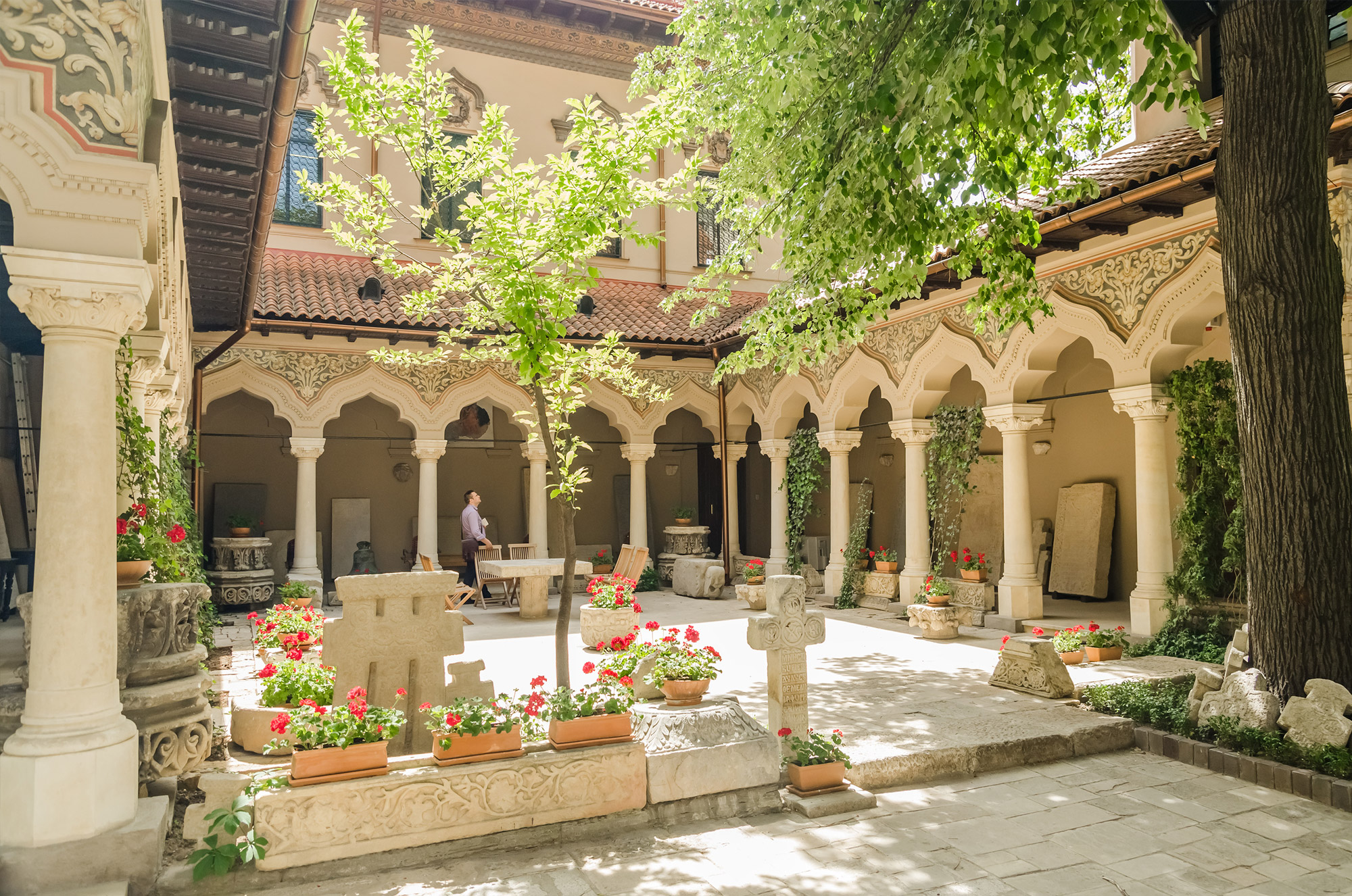
Catedrala Sfantul Iosif
Address: Str. General H M Berthelot 19
Tel: (+4) 021 312.12.08
The red brick Roman Catholic, innaugurated in 1884) combines Gothic and Roman elements.
Organ recitals are held every week.
Biserica Sfantul Nicolae
Address: Str. Ion Ghica 9
Tel: (+4) 021 314.64.50
Built in 1909 by the Russian Tsar Nicholas II for 600,000 gold rubles, this Orthodox Church has a wooden, gold-gilded iconostasis allegedly modeled after the altar in the Archangelskiy Cathedral in Moscow.
Jewish Bucharest
Bucharest is home to one of the oldest and most important Jewish communities in Romania. Sephardic Jews arrived here in the 16th century. Around the beginning of the 17th century, during the Cossack uprising, the first Ashkenazi Jews came from Ukraine and Poland. A sacred brotherhood, a charity box and a prayer house were registered in 1715.
Some of the synagogues built during the 18th and 19th century also featured ritual baths (mikve). By 1832, 10 holy houses had been established. Their number would increase significantly before the end of the century, almost every one having its own Rabbi and cult performers.
At the beginning of the 20th century, the Jewish population in Bucharest numbered 40,000 people with 70 temples and synagogues. From this great number, only a few survived the brutality of history - fascism and communism - and two still serve the city's present Jewish community.
Museum of the History and Culture of the Jewish CommunityMuzeul de Istorie si Cultura a Evreilor din Romania "Dr. Nicolae Cajal"
Address: Strada Mamulari 3
Tel: (+4) 021 315.08.37
Open:
Mon. - Thu.: 10 a.m. - 5 p.m.
Sun. 9 a.m. - 12:30 p.m.
Closed: Fri., Sat., on Jewish holidays and on Romania national holidays.
Admission Charge
Housed in the magnificently preserved Great Synagogue (1850) in the city's historic Jewish neighborhood,
Bucharest's Museum of the History and Culture of the Jewish Community presents the history of Romania's Jewish population.
The displays include a collection of books written, published, illustrated or translated by Romanian Jews,
paintings of and by Romanian Jews (many of the same artists' works are exhibited in the
National Museum of Art)
and memorabilia from Jewish theatres including the State Jewish Theatre.
The museum also contains a large collection of Jewish ritual objects, collected by Rabbi Moses Rosen (1912-1994), the late Chief Rabbi of the Romanian Jewry.
Templul Coral
Address: Strada Sfanta Vineri 9
Tel: (+4) 021 312.21.96
Resembling Vienna’s Leopoldstadt-Tempelgasse Great Synagogue, the Choral Temple in Bucharest was constructed in 1864 -- 1866, after plans by Enderle and Freiwald. It is the largest active synagogue in Bucharest, noted for its yellow and red arabesque-style bricks decorations, Moorish turrets, choir loft and organ. Other interesting features include the ladies’ galleries - two floors of seating for women. Choral Temple welcomes visitors, passport is required to access the building.
Sinagoga Yeshoah Tova
Address: Strada Tache Ionescu 9
On a busy, narrow, street just off Magheru Bulevard (one of Bucharest's busiest) stands the only other functioning synagogue in the city, apart from the Choral Temple. Services take place at Sabbath hour on Fridays and Saturdays.
Bucharest Jewish Community
Comunitatea Evreilor din Bucuresti
Address: Strada Sfanta Vineri 9
Tel: (+4) 021 313.17.82
...Bucharest Travel Notes Flavors of Old Bucharest
What foreign visitors said about Bucharest at the end of the 19th / beginning of the 20th century:
As early as 1879, Emile-André Lecomte du Noüy - French architect and restorer noticed Bucharest's "power and vitality".
It was during his time that Bucharest became known to the “flâneurs” of high-society France as “Little Paris”,
for its adoration of all things Gallic in its architecture, academia, and cuisine.
(flaneur = a person who saunters around observing society).
“Bucharest has been transformed rapidly with the increasing wealth of its inhabitants and fully deserves now its sobriquet of the “joyful city.” (French geographer Jacques Élisée Reclus - 1883).
In 1905, his compatriot, André Bellessort, French poet and essayist but also an avid traveler
spoke of the "cheerful" character of Bucharest, a city drowned in greenery, of its "interminable" streets,
in which "the hut leans against the mansion wall, the spectre of the hovel against the illusion of the Palace".
The different ethnic groups are not too mixed: there's an Armenian neighbourhood,
a Jewish, a Bulgarian, and areas with Greek street-vendors.
He is impressed by the new public buildings: the National Bank, "the most beautiful temple to blind luck",
The House of Deposits and Consignments, "so gracious, everyone gets enticed
to see art objects deposited there and all of painter Nicolae Grigorescu works",
the Palace of Justice, "capable of holding the pleaders and lawyers of the entire world",
The Post Office Palace, so big it crushes the neighbourhood.
Bellessort also mentions the elegant Bucharest people strolling along
‘Calea Victoriei’ and ‘the Șosea’, then the pompous funerals, where even the poor luxuriate,
and finally, the "gentle morals" of the population.
Another Frenchman, Alphonse Muzet, ingineur, Charge de mission en Orient
- who knew the city around the time of First World War - was impressed by the large number of churches and hospitals.
But what particularly strikes him is the "display of feminine luxury";
the elegant women on the Calea Victoriei are dressed "with a care one finds only in the great capitals."
(Le Monde Balcanique: : Roumains de Roumanie, de Transylvanie et de Bukovine ...)
Count Charles Louis Stanislas de Moüy, French - writer and diplomat - who,
bemused by Bucharest, observed it was difficult to find one’s place in a city whose neighbourhoods
veered so radically from first-world elan to seemingly intractable poverty,
with crooked streets neighbouring a Champs-Élysées-like avenue, luxurious and ox-drawn carriages on the same streets,
elegant people and very poorly dressed bystanders, decrepit shops and fine boutiques, mansions next to huts and shacks.
(Attribution:
JSTOR, nonprofit library for the intellectually curious)
...
Flavors of Old Bucharest / Little Paris
Mititei - 'Littles' or the 'Wee-Ones' - skinless beef sausage.
An immensely popular dish in Romania, the Mititei (Mici for short)
were first offered to customers - in the mid-1800s - at Casa "La Trei Frunze de Vita"
a Bucharest restaurant known for its delicious traditional dishes
and for the atmosphere entertained by the best musicians of the time.
Writer Constantin Bacalbașa (1856-1935) states in his book "Bucharest of Another Time" that the "Mititei"
were an unplanned variation of a - popular at the time - beef sausage.
When the restaurant's owner, ran out of mutton intestine, which he usually used for sausage cassing,
he decided to put the meat directly on the grill.
The genuine Mititei are made from beef neck.
If the meat is too lean, some cow's or muton's tallow is added (100 to 150 grams per kg. of meat).
Other ingredients include (thick) beef bone broth (broth obtained from 500 g of bones for each kg of ground beef),
Sodium bicarbonate (8g), lemon juice (one teaspoon), vegetable oil (one spoon), extra fine ground black pepper (8 g.),
dried thyme (12 g.), allspice (2 g.), coriander (2 g.), Turkish cumin (2 g.), star anise (1 g.),
strained garlic juice (one clove, little salt and water / 1 kg of meat).
Meat is twice-grinded then mixed with half of the beef-bone broth. The following ingredients are then added, little by little, in the following order: Sodium bicarbonate, lemon juice, half of the beef-broth and the spices. The original recipe requires mixing/kneading the ground meat for at least one hour.
The meat mixture is refrigerated for 24 hours then removed from the refrigerator
left for a few hours at room temperature then mixed again, for half an hour, with the remaining beef broth.
At the end, the strained garlic juice is added to the mixture which is kneaded, once more, for another 15 minutes.
Meat is refrigerated for another 24 hours.
Getting the Mititei ready to be served:
Meat is removed from the fridge and left at room temperature, for about three hours.
Small skinless sausages (3 inches long and 1.25 inches thick) are hand-shaped and placed on a hot grill (wood embers).
The Mititei need to be medium-cooked, taking care not to dry out the juices that contain spice's flavor.
Some sources indicate that, during grilling, the Mititei are occasionally drizzled with garlic sauce and are flipped three times.
(Attribution: Libertatea.ro)
Orasanu also called "La Idee" (the idea) the popular restaurant "La Trei Frunze de Vita".
Mititei were formally introduced to the international gourmands at Exposition Universelle (Paris - 1889), Exposition Universelle (Paris - 1900) and the New York World's Fair (1939).
The Mititei are served as a snack or as main dish, usually with mustard as a condiment.
Most restaurants in Romania are offering "Mititei" but,
very, very few of - if any - them prepare them following the original recipe.
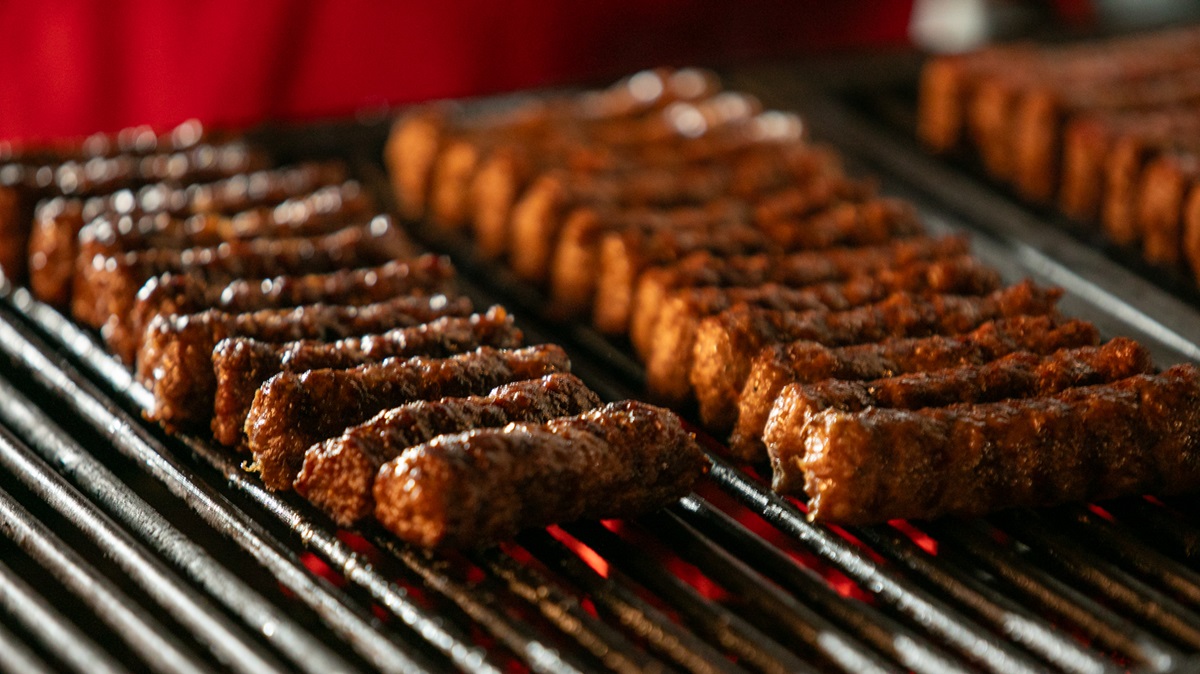
Svart – a slightly bitter drink with distinctive aroma and flavor.
During the inter-war years, some of Bucharest's cafés and restaurants became famous for their vibrant atmosphere and excellent ‘șvarț’.
Șvarț - from German ‘schwarz(-kaffee)’ or black(-coffe) -
was made from coffee substitutes such as chicory or roasted barley or from coffee and chicory, using the pour-over/drip method.
At the beginning of the 1940s, this affordable alternative to real coffee, which could be expensive or hard to find at times ,
got serious competition from the so-called Turkish coffee (made from chickpeas, millet, or fig seeds).
Today, the Svart is very hard to find in Romania as most people prefer expresso or filter-coffee.
Ironically, a Romanian entrepreneur may have contributed to the waning of the svart-drink:
Francesco Illy, inventor of illeta - considered the blueprint for the modern espresso machine (born in Timisoara in 1892).
However, the Svart remains a symbol of the inter-war period, evoking nostalgia for the times when Bucharest was nicknamed 'the Little Paris'.
Marghilomana:
a beverage named after political figure Alexandru Marghiloman (1854 – 1925), a conservative leader and ex-prime minister.
One day, while out hunting, Marghiloman asked for a coffee. Lacking water, his butler asked permission to use brandy to prepare the coffee.
Marghiloman agreed and so "Marghilomana" was born.
Here is how the original 'Marghilomana' is prepared:
100 ml (3.5 fl.oz.) of Jamaica Rum or brandy are placed in a small, cooper, kettle and mixed with two teaspoons of sugar.
The kettle is dunked into a bed of hot sand (or ember) and brought to a boil, at low heat.
Three teaspoons of coffee are added, the kettle is covered, and left to rest until the ground coffee sinks to the bottom (about three minutes).
As alcohol does partially evaporate during cooking the resulting drink is not very strong and it has a unique flavor.
Marghilomana was traditionally served in a small, spoutless cup called 'filigeană'.
Marghiloman was one of the largest landowners in Romania.
Besides politics, his greatest passion was horses.
He founded the first equestrian center in Romania, complete with modern stables, qualified staff and a race-course
and is often referred to as "the father of Romanian equestrianism".
Alexandru Marghiloman Mansion (Conacul Marghiloman) in Buzau, his home-town, is today open to visitors.
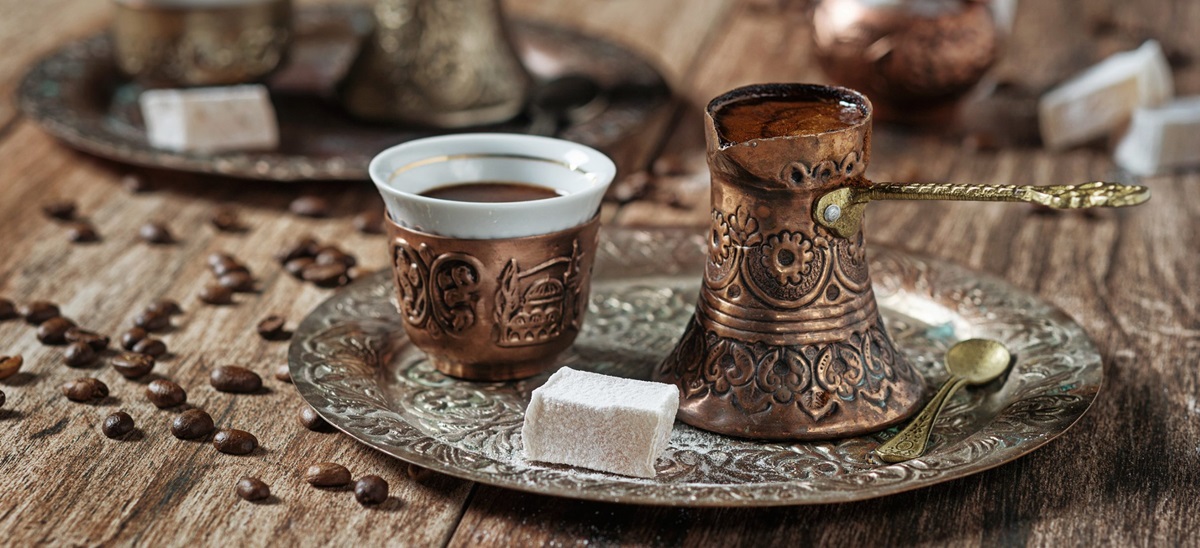
Joffre - the chocolate ‘cylinder’,
a dessert created by Romanian confectioner Grigore Capșa and adopted, with open arms, by French confiseurs.
First prepared in 1920 to honor the visit to Romania of French Field Marshal Joseph Jacques Césaire Joffre,
the shape of this chocolate dessert is reminiscent of a French military helmet.
The ingredients used to this day are: petit-four/ langue de chat (pastry),
butter, sugar, eggs, flour, flavorings and, above all, cocoa of the highest quality,
all coated in a delicious chocolate glaze.
(historia.ro)
Joffre is still available in many cake shops including Cofetaria Capsa and Zexe Braserie - Zelateria .
Carolines
Rum soaked biscuit filled with lots of cocoa buttercream
and topped with whipped cream and shaved chocolate.
(created by confectioner Emil Frederic).
Currently not offered by cake shops in Romania.

...
Bucharest Museums
Bucharest Art Collections Museum
Muzeul Colectiilor de Arta
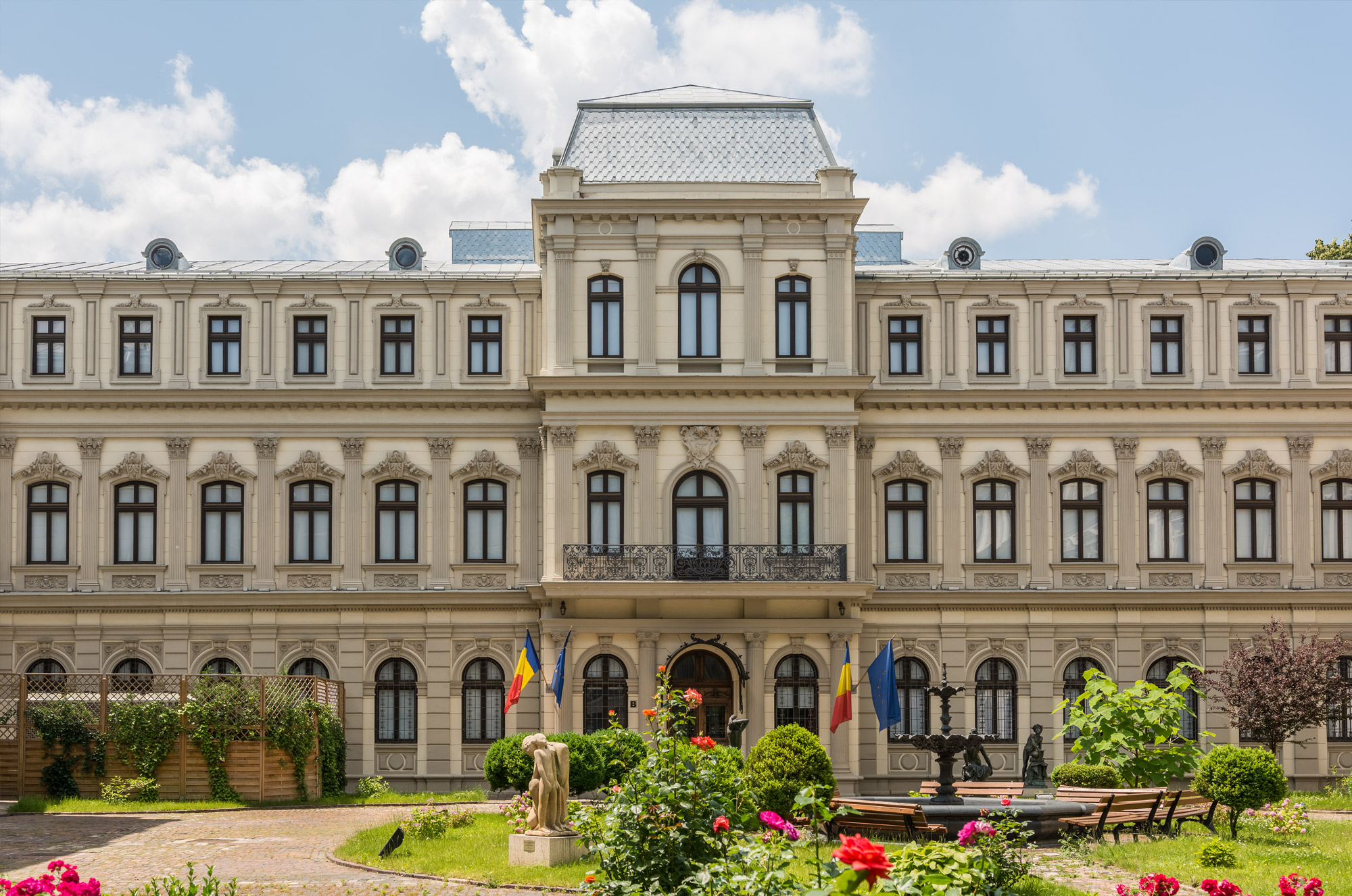
Founded in 1978, the Art Collections Museum, houses private collections donated over the course of time.
Collections include European and Oriental art works.
Address: Calea Victoriei 111
Tel: (+4) 021 212.96.41
Admission charge
Bucharest History & Art Museum
Muzeul Municipiului Bucuresti
Housed in the neoclassical Sutu Palace (1834), the museum features some 300,000 artifacts, from coins, books, maps,
engravings, paintings, arms and furniture to old traditional costumes.
Among the most valuable exhibits are the document attesting for the first time the name of the city of Bucharest, issued by Vlad Tepes in 1459,
and a sword set in precious stones that belonged to Prince Constantin Brancoveanu (1688-1714).
Address: Blvd. I.C.Bratianu 2
Tel: (+4) 021 315.68.58
Open: Wed. - Sun. 10 a.m. - 6 p.m.
Admission charge
Address: Soseaua Kiseleff 3
A small, but fascinating, room is home to an interesting collection of communist-era bust sculptures (including that of Lenin), paintings and memorabilia.
Cotroceni Palace & Museum
Muzeul National Cotroceni
A former royal residence built between 1679 and 1681 by Prince and ruler Serban Cantacuzino, the palace was home to King Carol I, who made important changes in its architecture. At the end of the 19th century, Heir-to-the-Crown Ferdinand ordered the partial demolition of the palace, which was later reconstructed by French architect Paul Gottereau in neoclassical style. In 1977, Nicolae Ceausescu transformed it into an official guesthouse with the addition of a new wing.
After 1990, the old wing of the palace became a museum.
The Oriental Hall, the Norwegian Hall and the Queen's Chamber are almost unchanged from the original design and are worth visiting.
A rich collection of medieval art can alsi be seen at Cotroceni Palace.
The new wing serves as the offices of the President of Romania.
Address: Bd. Geniului 1
Tel: (+4) 021 317.31.07
Open: Tuesday through Sunday
(closed during national holidays)
Admission charge (Guided tours are available in English)
Note: Visits by appointment only; fore reservatrions please call (+4) 0725 518.381 or E-mail Cotroceni Palace.
George Enescu - Museum of Romanian Music
Muzeul National George Enescu
Housed in the spectacular Cantacuzino Palace, George Enescu museum displays documents and various objects
that belonged to Romanian composer and violinist George Enescu (1881-1955).
Among items exhibited there is a Bach music collection he received as a gift from Queen Elisabeta of Romania.
A world-class violinist, Enescu studied at the Vienna Conservatory,
where he met German composer Johannes Brahms and where he also gave his first concerts.
In Paris, Enescu graduated from the French Conservatory in 1899.
His best-known works, the Romanian Rhapsodies, earned him national and international fame.
In 1936, his Oedipe tragic opera premiered in Paris and Enescu was awarded the French Legion of Honor award for the composition.
A member of the Romanian Academy and corresponding member of the Institute of France, George Enescu was the teacher of renowned violinist Yehudi Menuhin.
Every two years, the Romanian Athenaeum celebrates the maestro by hosting the George Enescu International Festival.
Address: Calea Victoriei 141
Tel: (+4) 021 318.14.50
Open: Tue. - Sun. 10 a.m. - 5 p.m.
Admission charge
Natural History Museum "Grigore Antipa"
Muzeul National de Istorie Naturala
Natural History Museum "Grigore Antipa" is the largest of its kind in Romania,
home to rich collections of reptiles, fish, birds and mammals as well as more than 300,000 artifacts and specimens are on display,
including a dinosaur fossil. A whole floor is dedicated to sea life and features examples of whales, dolphins and seals.
The museum also contains an unique collection of butterflies.
Address: Soseaua Kiseleff 1
Tel: (+4) 021 312.88.26
Hours / Admission
Dr. Nicolae Minovici Museum of Folk Art
Muzeul de Arta Populara
Dr. Nicolae Minovici Museum museum is home to the unique collection of folk art of Dr. Minovici
- founder of the Legal Medicine Association of Romania and publisher of the Romanian journal of Legal Medicine.
Items on display include traditional garbs and carpets from Bucovina (NE Romania) and from Walachia (southern Romania),
ceramic, glass-painted icons from Transylvania as well as early to mid-1900s works by Romanian artists
Eustaţiu Stoenescu, Arthur Verona, Bednarik, Costin Petrescu.
Address: Str. Dr. Minovici 1
Tel: (+4) 021 665.73.34
Admission charge
Ing. Dumitru Furnica Minovici Western Old Art Museum
Muzeul de Arta Veche Apuseana
The Gothic - Tudor mansion of ing. Dumitru Minovici, who made a fortune in the oil business in the 1930s,
is now a small but interesting museum that features a collection renaissance art as well as Belgian tapestries,
Dutch furniture, Swiss stained glass, a rich collection of rare books and Italian paintings from the 16th and 17th centuries.
Address: Str. Dr. Minovici 3
Tel: (+4) 021 665.73.34
Admission charge
Museum of the Romanian Peasant
Muzeul Taranului Roman
Address: Sos. Kiseleff 3
Tel: (+4) 021 317.96.60
Open: Tue. - Sun.: 10 a.m. - 6 p.m.
Admission charge
Opened in 1906, the museum features the richest folk art collection in Romania, with over 90,000 artifacts that trace the colorful and diverse cultural life of the Romanian people. The Pottery Collection includes some 18,000 items, representative of the most important pottery centres in the country. The oldest ceramic item found in the museum bears the inscription 1746. Equally impressive, the Costume Collection comprises almost 20,000 traditional folk costumes, some dating from the beginning of the 19th century, giving visitors insight into the styles and traditions of the Romanian peasants.
The displays dip into all aspects of life in the Romanian countryside. Exhibits of agricultural tools, carpets, icons, furniture, photographs and films build up a complete picture of Romanian folk culture. In one of the galleries, you can see a wooden church and in another, a wooden peasant house. Four more wooden churches stand in the outdoor museum area. In 1996, the museum was named European Museum of the Year. Visitors can buy regional handcrafts and textiles in the museum's extensive gift shop.
National Art Museum
Muzeul National de Arta
Address: Calea Victoriei 49 - 53
Tel: (+4) 021 313.30.30
Open: Wed. – Sun.. 11 a.m. - 7 p.m. (May - September);
Wed. - Sun. 10 a.m. – 6 p.m. (October - April)
Admission charge (English-speaking guides available)
Romania's leading art museum was founded in 1948 to house the former Royal Collection,
which included Romanian and European art dating from the 15th to the 20th century.
Located in the neoclassical former Royal Palace, set amid a wealth of historic buildings
such as the Romanian Athenaeum, Kretzulescu Church and the Hotel Athenee Palace,
the museum currently exhibits over 100,000 works divided into two major sections.
Its National Gallery features the works of major Romanian artists, including Grigorescu, Aman and Andreescu.
There is also a roomful of early Brancusi sculpture, such as you won't find anywhere else,
demonstrating how he left his master, Rodin, behind in a more advanced form of expression.
The European Gallery, comprising some 15 rooms, displays little-known art gems of
El Greco, Monet, Rembrandt, Renoir, Breughels (father and son) Cezanne and Rubens.
If you only have time to visit one gallery, make it the Romanian one.
It is the most complete collection of Romanian works of art in the country and quite possibly, the world.
National Geology Museum
Muzeul National de Geologie
Address: Sos. Kiseleff 2
Tel: (+4) 031 438.17.44
Open: Mon. - Sun. 10 a.m. - 6 p.m.
Admission charge
Impressive collections of minerals and quartz formations are on display at Bucharest Geology Museum,
including a well-presented geological structure of Romania's territory.
National History Museum
Muzeul National de Istorie al Romaniei
Address: Calea Victoriei 12
Tel: (+4) 021 315.82.07
Open: Wed. - Sun. 10 a.m. - 6 p.m.
Housed in a 1900s neoclassical building that once served as the city's main post office, the museum offers a great introduction to the exciting history of Romania. Spread throughout 41 rooms, the exhibits recount the country's development from prehistoric times to the 20th century. The highlight is the National Treasury Hall where visitors can enjoy a dazzling display of some 3,000 gold items, including jewelry and valuable Neolithic artifacts.
Among the displays are the 12 pieces of the 4th century Pietroasele Treasure Collection. First presented at the 1867 World's Fair in Paris, it was considered the most valuable treasure collection in the world (the tomb of Tutankamon had not yet been discovered). One year later, the collection was displayed at the Second Annual International Exhibition in London and in 1872, at the International Exhibition in Vienna.
National Military Museum
Muzeul Militar National "Regele Ferdinand I"
Address: Str. Mircea Vulcanescu 125 - 127
Tel: (+4) 021 638.76.30
Open: Tue. - Sun. 9 a.m. - 5 p.m.
Admission charge
Founded in 1972, the museum illustrates the most important battles for independence and freedom in Romanian history.
The museum features collections of Oriental and Occidental weapons, Romanian and foreign uniforms,
military medals and awards, trophies, artillery, canons and airplanes as well as a library of historical military documents.
The centerpiece is the 1989 Revolution exhibit,
displaying mainly personal belongings donated by families of soldiers and civilians killed during the upheaval.
National Museum of Contemporary Art
Muzeul National de Arta Contemporana
Address: Calea 13 Septembrie 1, Intrarea E4
Tel: (+4) 021 411.10.40
Open: Wed. - Sun. 10 a.m. - 6 p.m.
Admission charge
Bucharest's newest museum, the MNAC, as it is often called by museum-goers, displays works of Romania's contemporary artists
as well as many temporary exhibits by international artists. The museum is housed in a wing of the Palace of Parliament,
the space which would have served as Nicolae and Ileana Ceausescu's private apartment
(where just the bathroom occupied 680 square feet, while the adjoining boudoir was three times that size).
National Museum of Old Maps & Books
Muzeul National al Hartilor si Cartii Vechi
Address: Str. Londra 39
Tel: (+4) 021 230.44.68
Open: Wed. - Sun. 10 a.m. - 6 p.m.
Admission charge
A must visit museum for all visitors interested in old maps and books.
Residence of Romania’s former Communist leader Nicolae Ceausescu
Muzeul Palatul Primaverii
For a quarter of a century (1965 - 1989) the “Spring Mansion” served as the private residence of Nicolae and Elena Ceauşescu and their three children, Nicu, Zoia, and Valentin.
A variety of woods, both native (oak, sycamore, cherry, walnut) and exotic (mahogany, rosewood, African pear, Canadian cherry), have been used for building and decorations.
The residence is home to an impressive collection of paintings by Romanian painters: Octav Băncilă, Camil Ressu, Rudolf Cumpăna, Dumitru Ghiață, George Baron Lowendal, handmade tapestries and mosaics designed by Romanian artists Olga Porumbaru and Florin Pârvulescu.
Address: Bulevardul Primaverii 50
Telephone: (+4) 021 318.09.89
Open: Tue. - Sun.: 10 a.m. - 5 p.m.
Admission charge
All tours - group or individual - must be booked in advance.
Romanian Railways Museum - Bucharest
Muzeul Cailor Ferate Romane
The Railways Museum exibits include one of the largest train diorama in Europe, an 1869 Morse telegraph,
railways memorabilia including pictures and Romanian Railways uniforms.
Several passenger train wagons and engines are on display in the open-air section of the museum.
Address: Calea Grivitei 193 B
Tel: (+4) 021 222.75.20
Access: Nord Train Terminal (Gara de Nord), track # 14.
Open: Wed. - Sun. 10 a.m. - 6 p.m.
Admission charge
"Frederic and Cecilia Storck" Art Museum
Muzeul de Arta Frederic Storck si Cecilia Cutescu-Storck
Address: Str. Vasile Alecsandri 16
Telephone: (+4) 0722 574 897
Open: Wed. - Sun. 10 a.m. - 6 p.m.
Admission charge
"Storck" Art Museum pays tribute to sculptor Frederick Storck,
founder of the Romanian school of architecture, and his wife, Cecelia Cutescu-Storck,
an artist, arts professor and keen advocate of enhanced recognition for women in the arts.
150 paintings, 250 sculptures and a rich collection of antique coins, bronze medals and icons
are exhibited in the elegant, former, residence of Storck family -
a mansion, completed in 1913, designed by Frederic and Cecilia Storck, with help of architect Alexandru Clavel.
Bucharest Museum of Technology
Muzeul Naţional Tehnic Dimitrie Leonida
Address: Str. General Candiano Popescu 2 (Carol Park)
Tel: (+4) 021 336.93.90
Open: Wed. - Sun. 11 a.m. - 6:30 p.m.
Admission charge
Bucharest Museum of Technology displays some 5,000 items covering a wide range of industrial models:
turbines, compressors, steam engines, the cylinder from the first steam engine that was used in a Romanian factory,
as well as antique cars and motorcycles.
Painter Theodor Pallady Museum
Muzeul Theodor Pallady
Address: Str. Spatarului 22
Tel: (+4) 021 211.49.79
Open:
Wed. – Sun.. 11 a.m. - 7 p.m. (May - September)
Wed. - Sun. 10 a.m. – 6 p.m (October - April)
Admission charge
Housed in the beautifully restored Melik house, built around 1750
by the rich Armenian businessman Hagi Kevork Nazaretoglu,
the museum features paintings and sketches by Romanian artist Theodor Pallady
as well as numerous other art objects.
Village Museum
Muzeul Satului
Address: Soseaua Kiseleff 28 - 30
Tel: (+4) 021 317.91.03
Open: Mon. 9 a.m. – 5 p.m.;
Tue. - Sun. 9 a.m. - 7 p.m.
Founded by royal decree in 1936, this fascinating outdoor museum, the largest in Europe,
covers some 30 acres on the shores of Lake Herastrau in Herestrau Park.
It features a collection of original 50 buildings representing the history and character of Romania's rural architecture.
Steep-roofed peasant homes, thatched barns, log cabins, churches and watermills from
all regions of the country were carefully taken apart, shipped to the museum and rebuilt in order to recreate the village setting.
Throughout the year, the Village Museum hosts special events where you
will have a chance to witness folk artisans demonstrating traditional skills in weaving, pottery and other crafts.
Folk arts and crafts are available at the museum gift shop.
"Krikor H. Zambaccian" Art Museum
Muzeul de Arta Krikor Zambaccian
Address: Str. Muzeul Zambaccian 21 A
Telephone: (+4) 021 230.19.20
Open: Wed. - Sun.: 11 a.m. - 7 p.m. (May - September)
Wed. - Sun.: 10 a.m. - 6 p.m. (October - April)
Admission charge
The museum exhibits the private art collection of art critic and collector Krikor Zambaccian (1889-1962).
Works of Romanian painters: Ion Andreescu, Nicolae Grigorescu, Stefan Luchian, Theodor Pallady and Nicolae Tonitza,
who have been inspired by the Impressionists, can be admired at the Zambacian Museum.
Although Zambaccian was a big patron of the art of his home country,
during his studies in Belgium and France (1907 - 1913)
he purchased numerous European works from artists such as Cezanne, Renoir, Delacroix, Corot, Derain, Matisse, Pissaro, Bonnard, Utrillo and Picasso.
The museum preserves the initial display as it was conceived by the art collector himself.
There are also several beautiful small sculptures that complement the canvases.
Dr. George Severeanu Museum
Muzeul “George Severeanu”
Address: Str. Henri Coandă 26
Telephone: (+4) 021 212.96.48
Hours: 10 a.m. - 6 p.m., Wednesday through Sunday
(ticket office closes at 5:30 p.m.)
A fine example of Bucharest architecture of the mid-1800s,
the former residence of radiologist Severeanu - an avid collector of antiquities -
houses one of Bucharest's most interesting small museums.
Muzeul “George Severeanu” displays ancient Greek vases, clay, bronze and marble statuettes,
Roman glassware, ancient gems and cameos, Cucuteni, Vădastra, Wietenberg and Boian cultures pottery,
as well as over 9,000 coins from different historical periods (Ancient Greece to modern).
Bucharest Firefighters Museum -- Fire Lookout Tower
Muzeul Naţional al Pompierilor - Foişorul de Foc
Address: Bd. Ferdinand I nr. 33
Telephone: (+4) 0757 070.073
Open: daily 10 a.m. - 10 p.m.
Museum of Senses
Muzeul Simturilor
Address: Bulevardul Vasile Milea 4 - Cotroceni AFI Shopping Mall
Telephone: (+4) 0757 070.073
Open: daily 10 a.m. - 10 p.m.
Romania’s equivalent of Ripley's Believe It or Not is a place for fun and entertainment
and a bad weather ‘refuge’ for locals and visitors.
Performing Arts
Bucharest has numerous drama theatres and concert venues.
Tickets can be purchased on-line or at the venue's box office.
National Opera & Ballet
Opera Nationala Romana
Address: Blvd. Mihail Kogalniceanu 70 - 72
Tel: (+4) 021 313.18.57
Box office hours:
Mon. - Sun.: 10 a.m. - 1 p.m. and 2 p.m. - 7 p.m.
The city's artistic life stood up to its Parisian nickname in the 1930s and today, is as vibrant as ever. The Opera House, completed in 1953, is worth visiting, not only for its brilliant performances but also for the lavish interior design. The world-renowned Romanian Opera performs in Romanian as well as Italian and German. You will be able to enjoy the classic repertoire - Puccini, Verdi, Rossini, Mozart -, innovative staging, lavish costumes, seasoned performers and choreographers. The Romanian National Ballet also performs in this theatre. Performances are held Wednesday through Sunday evenings, except during July and August.
National Operetta Theatre
Teatrul National de Opereta 'Ioan Dacian'
Address: Bd. Nicoale Balcescu 2
Tel: (+4) 021 313.63.48
Comic plots, extravagant staging, lavish costumes, high caliber singers and orchestra are all part of the charm of the light,
frothy performances at the Ion Dacian Operetta.
George Enescu Philharmonic at Romanian Athenaeum
Filarmonica George Enescu
Address: Str. Benjamin Franklin 1
Tel: (+4) 021 315.00.26 or 315.25.67
The Romanian Athenaeum is the main venue of the biennial classical music festival "George Enescu"
Festivalul de Muzica Clasica "George Enescu"
Famous artists and conductors have performed here throughout the years.
Among them: Erich Kleiber, Sergiu Celibidache, Ionel Perlea, Herbert von Karajan, Dinu Lipatti, Arthur Rubinstein, Pablo Casals and Yehudi Menuhin.
National Radio Orchestra and National Chamber Orchestra
Orchestra Națională Radio
Address: Str. General Berthelot 60-64 (Sala Radio)
Tel: (+4) 021 303.12.11 or (+4) 303.14.28
The National Radio Orchestra, one of the best in the country, offers classical chamber music performances
at Studioul de concerte „Mihail Jora”
(941-seats), known for its excellent acoustics.
Theatre performances are popular in Romania; tickets for most shows, offered by Bucharest's 16 major theatres, sell-out within hours.
Most theatre productions are performed in Romanian. Hoever, performances in French, German or English are oftern offered by small theatres.
Theatre season begins in September and ends in July.
Some small student and underground theatres do remain open during summer.
Bucharest National Theatre
Teatrul National Bucuresti
Address: Blvd Nicolae Balcescu 2
Tel: (+4) 021 314.71.71
Three auditoriums offer a broad selection of both classical and contemporary Romanian and intyernational playwrights.
The theatre's Great Hall (Sala Mare), hosts the grand productions,
while the Amphitheatre (Sala Amfiteatru) shows smaller productions and TV shows,
and the Studio Hall (Sala Atelier) gets a mix of lower-key shows and presentations.
State Jewish Theatre
Teatrul Evreiesc de Stat
Address: Str. Dr. Iuliu Barasch 15
Tel: (+4) 021 323.39.70
Bucharest Jewish Theatre offers performances in Yiddish, Hebrew and Romanian (translation into Yiddish and Hebrew available).
Bucharest Circus
Circul Globus Bucuresti
Address: Aleea Circului 1
Tel: (+4) 021 210.24.19
Built in 1960, the enormous, permanent big-top circus is the centerpiece of the small park called Circus Park.
With seating for more than 3,500 spectators, Bucharest's circus continues to host excellent performances, put on by both local and touring circus companies.
Cismigiu Gardens
Gradina Cismigiu
Address: Blvd. Regina Elisabeta
(across from Bucharest City Hall)
Designed in 1845 by the German landscape architect Carl Wilhelm Meyer, the garden opened to the public in 1854.
The name, Cismigiu, comes from the Turkish cismea, meaning "public fountain."
More than 30,000 trees and plants were brought from the Romanian mountains,
while exotic plants were imported from the botanical gardens in Vienna.
Cismigiu is Bucharest's oldest park and a great place to stroll and enjoy a break from the hectic city. Set amid green lush lawns and winding paths,
the park offers a lake with rowboat rentals, a beer garden, a playground for children,
a chess area for amateurs and plenty of park benches for relaxing and people-watching.
Gradina Botanica - „Dimitrie Brandza"
Opened in 1891, this 45-acres garden features over 10,000 species of plants from Romania and around the world.
The garden is also home to the Botanical Garden Museum, housed in a beautiful "Brancovenesc" - Style building.
Visitors can peruse manuscripts, old botanical research devices and a collection of artifacts made of vegetal materials.
The huge greenhouses (44,000 square-feet) are open to visitors:
Tue, Thu and Fri.; 10 a.m. -- 3 p.m.
Sat and Sun: 9 a.m. -- 1 p.m.
Address: Sos. Cotroceni 32
(across from Cotroceni Palace)
Tel: (+4) 021 410.91.39
Open-Air spaces Hours:
March 16 -- October 15, daily 8 a.m. - 8 p.m.
October 16 -- March 15, daily 9 a.m. -- 3:30 p.m.
Admission charge
Carol I Park
Parcul Carol I
Carol I Park is one of the most beautiful in the city of Bucharest.
Designed by French landscape architect Eduard Redont in 1900s, the park is a great place for walks down tree-lined paths.
In summertime, the aphiteatre "Arenele Romane" is a stage for open-air concerts.
A massive monument dedicated to the unknown Soldier offers good views of the central area of Bucharest and plenty of photo opportunities.
Address: Piata Libertatii
Parcul Regele Mihai I (Herăstrău)
Address: Soseaua Kiseleff 32
Spreading on 465 acres, from the Arch of Triumph to Baneasa Bridge,
King Michael I park encompases the 185-acres Herastrau lake.
Bucharest's largest park is home to numerous attractions and offers numerous activities.
For an overview of the park, take a boat ride around the lake or rent your own row-boat or water-bike.
Herastrau park is also home to the Village Museum, a delightful display of traditional rural architecture.
Amenities include: summer theatre, exhibition pavilions, nautical and sports clubs, a 3.7 miles running path surrounding the lake,
cafes and restaurants.
The area near the park is known for the beautiful mansions and displaying different architectural styles
from 19th century neoclassical to 20th century art nouveau and modern luxury villas.
Park of Youth
Parcul Tineretului
Address: Bd. Tineretului
210 acres of lush vegetation, tranquil lakes and meandering paths.
Sports facilities include: basketball, volleyball and tennis, paddle boat (rental).
skatepark, children's playgrounds (swings, slides, climbing walls and mini zip lines).
Picnic areas equipped with tables and shaded seating.
...
Bucharest Fountains Show
Simfonia Apei
Shows will be available until June 30, 2025
Effective June 30, 2025 shows will be Temporarily suspended
due to major infrastructure work to be completed by fall 2026.
Bucharest is home to the longest row of synchronized fountains in the world.
45 water fountains stretch 0.9 miles along Bulevardul Unirii and feature 180,000 square feet of colorful original mosaics.
A display of water, music, and light is offered on weekend evenings, mid-May until mid-October.
Admission: free
Best place to see the show:
Parcul Unirii
| Show start time: | |
|---|---|
| 9 p.m. | May and August |
| 9:30 p.m. | June and July |
| 8 p.m. | September and October |
2025 shows start date: May 23.
last 2025 show: Sunday - June 29.
...
Bucharest - Hop-on Hop-off Sightseeing Bus ToursCurrent Availability Status: Suspended
Bucharest Hop On-Off Tours have not resumed for 2025 warm season.
Bucharest Transport Authority has made no announcement, yet, on when tours will resume.
Hop-on, hop-off bus tours are operated daily - during the warm season - on a fleet of double-decker buses.
Visitors can get an introduction to Bucharest's fascinating architectural mix
and get familiar with the city's central neighborhoods and places of interest, in less than one hour.
Bucharest - Hop On/ Off Sightseeing Bus Tours Facts
Bucharest hop on/ off sightseeing tour operate during the warm season
2024 Dates of operation: June 1 - October 31 (weather permitting)
Hours of operation: 10 a.m. - 9:45 p.m.
Last departure from Piata Presei Libere to Piata Unirii at 9 p.m.
Last departure from Piata Unirii to Piata Presei Libere at 9:25 p.m.
Frequency: every 20 minutes
Total length of the route: 9.5 miles
Number of stops: 14 (see/print map)
24-Hour Ticket (card):
Adults: 25 lei (about $5.50)
Children (up to 7 years old): free
Youth (7 to 14 years old): 10 lei (about $2.25)
Note: Tickets can be purchased on board and at most hotels
and are valid for 24 hours from the time of validation.
Sights and major attractions along the route include:
Village Museum (Muzeul Satului), Arch of Triumph (Arcul de Triumf),
Natural History Museum (Muzeul Antipa), Geology Museum (Muzeul de Geologie),
Museum of the Romanian Peasant (Muzeul Taranului Roman),
Headquarters of the Romanian Government (Palatul Victoria),
The Romanian Athenaeum (Ateneul Roman), National Museum of Art (Muzeul National de Arta),
Church Cretulescu (Biserica Cretulescu), The Savings Bank (Palatul CEC),
National History Museum (Muzeul National de Istorie), Parliament's Palace (Palatul Parlamentului),
Romanian Patriarchy (Patriarhia Romana), Manuc's Inn (Hanul lui Manuc),
Bucharest University (Universitatea), City of Bucharest Museum (Muzeul Municipiului Bucuresti),
The National Theatre (Teatrul National), Academy of Economic Studies (Academia de Studii Economice)
...Bucharest Independent City Walks
This section is courtesy of Ms. Rosemary K. Rennon
The following walks are designed to guide you around the four main areas of Bucharest,
pointing out several unique sights.
Stray from the routes as you wish, as you're sure to find other interesting places along the way that are not mentioned here.
Allow approximately three hours for each walk.
Book your 'tips-based' Bucharest Walking Tour.
Select one or more from the many available.
Tip-based tours do not have a set ‘price’ and no upfront payment is required.
At the end of the tour each participant gives the guide the amount that she/he considers appropriate.
Walk # 1
North of City Centre
This beautiful walk takes you through the quiet area n orth of the city center. Begin at Piata Victoriei with the government's Victoria Palace (Palatul Victoria) on its east side. Cross the square and walk north along tree-lined Soseaua Kiseleff. On your left are the Grigore Antipa Natural History Museum and the Museum of the Romanian Peasant; a little farther up on the right is the National Geological Museum.
After passing through Kiseleff Park, stroll northward along the grand old mansions that line the shaded avenue all the way up to the Arch of Triumph (Arcul de Triumf). There begins Herestrau Park with its lake, gardens and outdoor restaurants. You will also pass the entrance to the wonderful open-air Muzeul Satului (Village Museum); take time to stop in and admire the numerous traditional rural architectural styles.
Ending at the north end of the park, off Piata Presei Libere you'll find the RomExpo exhibit center and the World Trade Center Plaza at Pullman (former Sofitel) Hotel. There's a fancy shopping arcade inside and a very nice coffee shop in the hotel where you can get a bite to eat. Catch bus # 335 back to Piata Charles de Gaulle for the Aviatorilor subway station (Metrou) or bus #331 to Piata Romana.
Walk # 2
West – Central Bucharest
This walk follows the route of Bucharest's most famous historic avenue, Calea Victoriei, Beginning at Piata Victoriei, walk south along Calea Victoriei passing Casa Vernescu, the George Enescu Museum, housed in the beautiful Cantacuzino Palace, and the Art Collections Museum.
Two blocks south of Bulevardul Dacia, detour left onto Strada Piata Amzei where you'll come upon the colorful open-air produce market (Piata Amzei). Return to Calea Victoriei and turn left to resume the walk south, stopping in the shops along the way.
Upon reaching Piata Revolutiei you will find the Athenee Palace hotel, the Romanian Athenaeum (Atheneul Roman) concert house (ask for an inside tour), the National Art Museum, housed in the former Royal Palace, the beautiful University Library, the former Communist Party Central Committee building, and finally, the Kretulescu Church built in 1725.
Continuing south on Calea Victoriei, you'll pass more shops and hotels; note the Odeon Theater, sitting back from the street on the left. On the right you'll come to The Military Club which has an outdoor café and an art gallery.
Turn west (right) at the corner onto Bulevardul Regina Elisabeta and follow it to Cismigiu Garden, he last stop on this walk. Stroll around the lake or just relax watching the rowboats. The boathouse café offers snacks and refreshments.
Walk # 3
East – Central Bucharest
This walk takes you along Bucharest's busiest commercial and shopping area. The boulevard changes names five times, but here you will cover the length of only three of its five sections: General Magheru, Nicolae Balcescu and I.C. Bratianu.
Starting from Piata Romana, you might first walk east on Bulevardul Dacia for a look at some of the embassy mansions; then return to Piata Romana.
Next, head south on Bulevardul General Magheru. The street is filled with clothing stores, sidewalk vendors, pastry shops, cinemas, stationary stores (papeterie), and crystal shops.
On the east side of the Bulevardul Balcescu section you will find the Libraria Noi bookstore
which has a good selection of American picture books and English novels.
There are several art galleries along here, including two in the National Theater which is next to the high-rise Grand Hotel Bucharest.
Behind the hotel are the American Consulate and the American Library.
Reaching Piata Universitatii, on the west side of the street you will see Bucharest University
and the sidewalk book and flower vendors; sit a moment at the fountain in the adjoining plaza and watch the activity.
The underground subway (Metrou) concourse has shops, newsstands and several fast food eateries, including a pastry shop and pizzeria.
This underground passage is the easiest place to cross the boulevards, rather than deal with street traffic.
South of Piata Universitatii the street name changes to Bulevardul I.C. Bratianu.
On your right is the Bucharest History & Art Museum, housed in the neoclassical Sutu Palace, built in 1835.
Farther down, across the boulevard will be Sfantul Gheorghe cel Nou Church, built in 1701. The eastern end of Strada Lipscani meets the boulevard on the west side.
Continuing south, you will end this walk at Piata Unirii where you will find department stores, a large grassy square with park benches to rest on and its enormous complex of fountains. Piata Unirii's two subway (Metrou) lines link with all other subway stops.
Walk # 4
South Bucharest
This route weaves through a tangle of colorful side streets in Bucharest's old historic district. Be extra alert here, as you will do some backtracking. Begin at the crossroads of Calea Victoriei and Bulevardul Regina Elisabeta. Walk south on Calea Victoriei, along the east side of the street. Duck into Pasajul Villa Cross (also called Pasajul Bijuteria), a golden skylit arcade of boutiques. Follow its U-shape back to Calea Victoriei and walk south a block, to the beginning of Strada Lipscani.
Stroll Strada Lipscani to see the vendors and shops, then return to Calea Victoriei.
Heading south again on Calea Victoriei, next turn left onto Strada Stavropoleos to arrive at Caru cu Bere restaurant. If you can't stop in for a beer or snack, at least peek inside to see its magnificent interior. Farther down the street is the tiny Biserica Stavropoleos (church), built in 1724. Here you can either cut south via Strada Postei to Strada Iuliu Maniu, or return to Calea Victoriei and go south, past the National History Museum to reach Strada Iuliu Maniu. Following Strada Iuliu Maniu east, you will come to the remains of the Curtea Veche (Old Princely Court) of the real Prince Dracula and his Princely Church, the oldest in Bucharest.
Just across the road is the former caravansary Hanul lui Manuc, now a restaurant and inn (currently closed for renovations). Go inside the courtyard for a look at its timbered design, or stop there for some food and drink.
From this point, take the narrow side street south to exit the neighborhood at the Dambovita River.
Across the river you will see the 120-year-old Palace of Justice. Cross the boulevard to reach the broad, green Piata Unirii. Here you can rest while watching the fountains and the people.
From the south end you can see Nicolae Ceausescu's huge "House of the People", now Parliament Palace. When rested, head west along Bulevardul Unirii toward the Parliament Palace; this area is the Civic Center. When you reach the building, turn right, and walk north, back to the river.
Cross the Dambovita again at the Izvor Bridge. Walk in a block to Bulevardul Regina Elizabeta, then turn right and you'll wind up across the street from Cismigiu Garden.
To end this walk continue east on Bulevardul Elisabeta to Calea Victoriei; or go a little farther toward Piata Universitatii and its subway (Metrou) station.
...
Bucharest free things to do
| Attraction/ Museum | When Free Admission is offered | Notes |
|---|---|---|
| Museum of Romania’s National Bank | year-round | Reservation mandatory |
| Piata Unirii Dancing Fountains | weekends, May through October | |
| National Library | year-round | Reservation mandatory |
| National Art Museum | first Wednesday of each month | |
| Museum of Art Collection | first Wednesday of each month | |
| K. H Zambaccian Museum of Art | first Wednesday of each month | |
| Theodor Pallady – Casa Melik | first Wednesday of each month | |
| Museum of city of Bucharest | first Saturday of each month | |
| „Frederic și Cecilia-Cuțescu Storck” Art Museum | first Saturday of each month | |
| Astronomical observatory | first Saturday of each month | |
| Museum of the Romanian Peasant | 26th day of each month | |
| Museum of Romanian Music / Cantacuzino Palace | 26th day of each month | |
| Painter Vasile Grigore Museum | last Wednesday of each month | More info |
National Day of Culture / birthday of Romania’s National poet Mihail Eminescu.
Book your 'tips-based' Bucharest Walking Tour.
Select one or more from the many available.
Tip-based tours do not have a set ‘price’ and no upfront payment is required.
At the end of the tour each participant gives the guide the amount that she/he considers appropriate.
...
Attractions Near Bucharest
Therme Bucharest - thermal water baths
Complexul Therme - Bucuresti
Location: village Balotesti
Address: Calea Bucureşti 1K
(15 miles north of Bucharest city-centre, 3 miles north of Bucharest International Airport)
How to reach Therme Bucharest:
Therme is located a short drive north of Bucharest city-centre
and is easily accessible with public transportation:
Bus to Therme:
Bus #100, from city-centre to Baneasa Airport, Otopeni townhall or Henri Coanda International Airport
connect with
Bus #442 to Therme
(Bus # 100 stops: Piata Unirii -- Universitate -- Piata Romana -- Piata Victoriei -- Piata Presei --
Aeroport Baneasa -- Primaria Otopeni -- Aeroport Henri Coanda)
Stops in bold are shared by bus (lines) #100 and #442.
Travel time: approx. 45-minutes, normal traffic conditions.
Bucharest public transportation schedules.
Train and connecting Bus to Therme:
Train from Bucharest Main Train Terminal Gara de Nord to Henri Coanda International Airport
connect with
Bus #442 to Therme
| Therme Bucharest fast facts | |
|---|---|
| Total Area | 62 acres |
| Indoor Area | 400,000 sq. ft. glass-and-steel structure |
| Capacity | 4,000 guests |
| # of Pools | 10 -- total area 32,500 sq. ft. |
| # of Saunas | 10 (6 dry and 4 wet) |
| Hours | Mon -- Fri: 10 a.m. to 11 p.m. Sat: 9 a.m. to 12 a.m. Sun: 9 a.m. to 11 p.m. |
| Admission | |
| Telephone: | (+4) 031 108 88 88 |
Thermen Bucharest features Romania’s most extensive sauna complex, Europe’s biggest urban beach and the largest greenhouse in Romania - over 800,000 plants, more than 1,500 palm trees, countless orchids and many other unique species including a Tree of Life (Ficus Religiosa).
Therme Bucharest sections :
~ Galaxy, amenities for children & family fun,
(16 waterslides, indoor and outdoor pools and a beach for children;
saunas, whirlpool baths, hydromassage beds, infrared armchairs and a swim-up bar for parents).
~ Palm, (adult-only) aimed for relaxation
(beach, three mineral pools, sauna rain forest, "Humboldt" fusion restaurant, lounge);
~ Elysium, focus on spa and wellbeing treatments
(treatment rooms, saunas, steam rooms, pools, lounge, Mango Tree restaurant).
...
Mogosoaia Palace & Brancovenesc Museum
Palatul Mogosoaia & Muzeul Brancovenesc
Where: 9 miles NW of Bucharest
Address: Str. Valea Parcului 1
Access:
Public transportation
From Bucharest train terminal:
subway M4 to Parc Bazilescu then metro-area bus 460 to Mogosoaia,
From downtown Bucharest:
bus # 331 to Damaroaia then metro-area bus 460 to Mogosoaia,
car, taxi
Tel: (+4) 0786 705.985
Hours:
Tue. - Sun.: 10 a.m. - 6 p.m. (May 1 - October 31)
Tue. - Sun.: 9 a.m. - 5 p.m. (November 1 - April 30)
Admission charge
Located in the village of the same name on the shore ofLake Mogosoaia, this palace reflects the Brancovenesc architectural style,
featuring traditional Romanian staircase balconies, arcades and columns.
Commisioned in 1698 by Walachian prince Constantin Brancoveanu
this summer residence features a beautiful Venetian-style loggia on the facade facing the lake
and a balcony with intricate Brancovenesc-style carvings overlooking the main courtyard.
Today, the palace houses Muzeul Brancovenesc with exhibits of valuable paintings, wood and stone sculptures,
gold and silver embroideries, rare books and precious manuscripts.
Inside the complex, there is also a church built in 1688 and decorated by a team of Greek artists.
The original interior murals have been well-preserved, including a painting showing Constantin Brancoveanu with his wife,
Maria, and their four sons and seven daughters, all wearing royal dress.
...
Monastery SnagovManastirea Snagov
Where:
25 miles north of Bucharest
Access: car or bus
Snagov Monastery more info
In 1458 - more than one hundred years after Snagov church was built
prince Vlad Tepes (Vlad the Impaler / Dracula) added thick defending walls and a dungeon.
A plaque on the floor inside the church marks the grave with the presumed remains of the world-known count.
The monastery is located on an island on lake Snagov, and can be accessed on a pedestrian bridge.
...
Day Trips from Bucharest
Bucharest is a good starting point to explore southern Transylvania, Dealu Mare wine region, the Black Sea coast or the city of Ruse in Bulgaria. Away from the buzz of the city, you will find a different side of Romania - life in the countryside moves more slowly, the air is crisp and hospitality natural.
Day trip to Peles and Bran castles and Brasov
Duration: 11 hours
Distance traveled: 265 miles
Itinerary: Bucharest — Sinaia — Bran — Brașov — Bucharest
Highlights: Peleș Castle - Sinaia, Bran (Dracula's) Castle - Bran, Brașov Old Town
More information and reservations
Here are some Bucharest day-trips ideas:
Peles Castle & Sinaia MonasteryWhere: Town of Sinaia, 88 miles north of Bucharest
Access: car, bus, train
Peles Castle info
Where: Village of Bran, 120 miles north of Bucharest
Access: car, train or bus to Predeal or to Brasov
Taxi from Predeal to Bran
Bus or taxi from Brasov to Bran
Dracula Castle info
Where: 115 miles north of Bucharest
Access: car, train or bus
Brasov info Zimbraria Neagra (European Bison Reserve) -- Targoviste -- Palatul Brancovenesc Potlogi
Where: northwest of Bucharest
Bucharest - Neagra Bison Reserve: 48 miles,
Stop/ visit: European Bison Reserve in village Bucsani
Neagra Bison Reserve -- Targoviste: 19 miles
Stop/ visits: the 14th century Princely Court(Curtea Domneasca) and Vhindiei Watchtower (Turnul Chindiei).
Targoviste -- Potlogi: 32 miles
Stop/ visit: Palatul Brancovenesc, residence of Prince Constantin Brâncoveanu, voivode of Wallachia (1688 -- 1714).
Potlogi - Bucharest: 36 miles.
Access: car
Itinerary map
Total distance: 135 miles Targoviste - Curtea de Arges - Poenari Fortress
Where: northwest of Bucharest
Distance: Bucharest - Targoviste: 52 miles,
Targoviste - Gaesti - Curtea de Arges - Poenari: 89 miles
Poenari - Bucharest: 112 miles.
Access: car
In Targoviste, tour the 14th century Princely Court(Curtea Domneasca) residence of voivode Vlad the Impaler - Draculea
and the Watchtower (Turnul Chindiei).
Hours: 9 a.m. to 5 p.m., Tuesday through Sunday.
From Targoviste, continue to town of Curtea de Arges.
In Curtea de Arges, visit the 14th-century Princely Court and the 800 years old Princely Church.
Curtea de Arges was founded in the late 1200s by Prince Radu Negru (Negru Voda).
From 1369 until 1431, Curtea de Arges was the capital of Wallachia (southern Romania).
A stunning architectural gem of the town is the 16th century, Byzantine style, with Moorish arabesques,
Curtea de Arges Monastery (Manastirea Curtea de Arges).
All Romania's kings and queens rest in the monastery.
Fifteen miles north of Curtea de Arges lay the ruins of Poenari Fortress,
the authentic stronghold of voivode Vlad Tepes (Vlad the Impaler) or Vlad Dracul.
The walls and towers of the fortress, located near village Arefu, still stand.
Access to fortress, perched on a cliff - high above the surrounding area, requires climbing of a 1,462-step stairway.
Where: 120 miles northwest of Bucharest
Access: car, bus
Fifty miles west of Curtea de Arges stands Hurezi Monastery,
the largest monastic settlement in Walachia, founded in 1690 by Prince Constantine Brancoveanu.
A masterpiece of Brancovenesc architectural style and a UNESCO World Heritage site,
Hurezi is renowned for the richness of its sculptural detail,
the treatment of its religious compositions and its painted decorative works.
Monastery Hurezi is home to precious collections of frescoes and icons dating from the end of the 17th century
and the beginning of the 18th century.
The nearby village of Horezu is one of the biggest pottery centres in Romania.
More than a century ago, local nuns taught the villagers how to make hand-paint their pottery and,
ever since, people have come from far and wide to see and purchase on Horezu ceramic.
Town of Targu Jiu
Where: 190 miles west of Bucharest
Access: car, bus, train
A visit to Targu Jiu is must for all art lovers, especially those interested in modern sculpture.
This former market town is closely associated with Constantin Brancusi, considered by many to be the father of modern sculpture.
While most of his works are on display in prestigious museums throughout the world, his trilogy of public sculptures:
The Table of Silence (Masa Tacerii), The Gate of the Kiss (Poarta Sarutului) and The Endless Column (Coloana Infinitului)
can be admired at the Constantin Brancusi sculptural complex in downtown Targu Jiu.
Nearby in Hobita, the birthplace of Constantin Brancusi, you can visit the house in which the sculptor spent his childhood;
it now houses a small museum dedicated to the master.
The house preserves the original architecture and accessories (the bed, the cellar and the well).
The village is also home to the national sculpture camp "Brancusiana".
Targu Jiu more info
City of Ruse in Bulgaria
Where: 48 miles south of Bucharest
Access: car, bus, train
Ruse (Russe) is located on the right bank of Danube river, a natural border between Romania and Bulgaria.
The city features fine examples of 19th and 20th-century Neo-Baroque and Neo-Rococo architecture.
Ruse-Giurgiu Friendship Bridge connects Ruse with town of Giurgiu in Romania.
Ruse landmarks of note include: "Sava Ognianov" theatre, "Aleksandrovska" street, The "Old High School of Music", Holy Trinity Cathedral,
Andrea Turio Mansion, Russe Historical Museum.
Ruse (Bulgaria) more info
...
Bucharest CasinosBucharest is one of the few cities in east-central Europe offering gambling opportunities. Guests can play blackjack, poker, craps, roulette, baccarat and other games of chance and listen to live music. Bucharest casinos, open 24-hours, include:
Palace Casino
Casa Vernescu
Address: Calea Victoriei 133
Tel: (+4) 021 311.97.44
PalaceCasino.eu
Grand Casino
J.W. Marriott Grand Hotel
Address: Calea 13 Septembrie 90
Tel: (+4) 021 403.08.01
GrandCasinoBucharest.ro
Platinum Casino
Address: Calea Victoriei 63 - 81
Tel: (+4) 031 710.22.34
ThePlatinumCasino.ro
CITY ESSENTIALS
Bucharest Transportation
Bucharest Public TransportationBucharest's public, above-ground, transport network includes:
102 bus lines (autobuz), 22 tram lines (tramvai),
14 trolleybus lines (troilebuz)
and six subway (metrou).
Buses, trams and trolley buses operate - with slight variations - between 4:30 a.m. and 11:50 p.m.
The subway operates - from 5 a.m. until 11 p.m.
24 bus lines (Linii de Noapte) serve the needs of locals and visitors that need public transport during the nighttime.
Bucharest public transport fare can be paid on-board with a contactless debit or credit card.
or with a public transport card that can be purchased at kiosks located next to most bus/ tram stops:
~ (Non-reloadable, transmissible) Prepaid cards (Card Multiplu)
are issued for free and can be used for two to 30 trips or for day, 3-days and 7-days pass.
~ (Reloadable, transmissible) Prepaid cards (Card Activ) cost 3.7 lei
and can be reloaded at any STB kiosk on on-line .
~ Reloadable, non-transmissible Activ cards are issued for free (4.7 lei fee for reissuing).
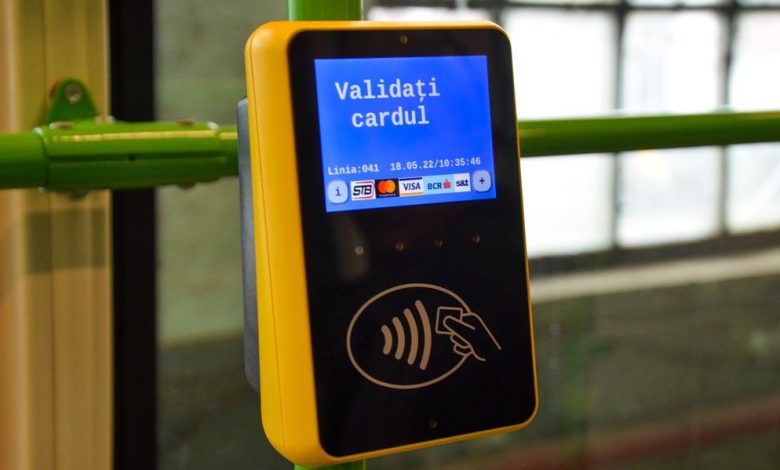
Bucharest Public Transport Tourist Card ("Card Călătorie Turist")
is available to visitors and residents.
This 'combo ticket' offers unlimited rides for:
~ train from Bucharest International Airport to Gara de Nord Train Terminal
~ all urban, above-ground, transport: bus, tram and trolleybus
~ Bucharest Metro (subway)
Cost of Bucharest Public Transport Tourist Card:
20 lei (approx. $4.45) / 24-hours card and
40 lei (approx. $8.70) / 72-hours card.
Tickets/cards must validated upon boarding.
Travelers may be asked to show the validated ticket/card during the trip.
Passengers that cannot show a validated ticket must pay a surcharge (Suprataxa).
Bucharest Public Transport (STB) Routes Map (Harta Traseelor)
Bucharest Public Transportation Schedules (Program de Circulatie)
Bucharest Public Transport Stops and Route Planner (Statii / Planificare Rute)
Feedback recently received from visitors to Bucharest indicates that their foreign-issued credit cards
have not been accepted/ transactions denied/ to pay the fare, onboad of bus # 100
(city-centre to Bucharest Airport) and, that Bucharest Transport Authority (STB) controllers
they have encountered where rather obtuse and aloof.
Most ticket kiosks attendants do not speak English or other foreign language, visitors to Bucharest also stated.
Bucharest above-ground local transportation (bus / tram / trolley bus) fares:
| Ticket type | Cost |
|---|---|
| one-trip (90 minutes) | 3 Lei (approx. $0.65) |
| 10-trips (90 minutes each trip) | 25 Lei (approx. $5.50) |
| day-pass | 8 Lei (approx. $1.80) |
| three-day pass | 20 Lei (approx. $4.45) |
| seven-day pass | 30 Lei (approx. $6.55) |
| month pass | 80 Lei (approx. $17.50) |
Tickets are interchangeable for bus, tram and trolley bus, except tickets for Express bus routes.
Above-ground & Subway 'combo' fares Metrorex - STB (bus / tram / trolley bus and subway) fares:
| Ticket type | Cost |
|---|---|
| one-trip, unlimited validations within 120 minutes | 5 Lei (approx. $1.10) |
| two-trips, unlimited validations within 120 minutes | 10 Lei (approx. $2.20) |
| 10-trips, unlimited validations within 120 minutes | 45Lei (approx. $9.50) |
| Day-pass, unlimited rides for one day | 14 Lei (approx. $3) |
| 3-Day Pass, unlimited rides for three days | 35 Lei (approx. $7.25) |
| 7-Day Pass, unlimited rides for seven days | 50 Lei (approx. $10.50) |
| Month pass, unlimited above-ground and subway rides | 140 Lei (approx. $29) |
...
Express Buss 100 (formerly bus $783)
operates 24 hours a day and connects Bucharest International Airport with Bucharest city-centre
Two or 10-journey tickets, as well as monthly passes, are available for all express buses.
There is direct train service from the city's main train terminal (Gara de Nord) to Bucharest international airport.
Express buss 442 connects the northern part of the city (Piata Presei / Exhibitions Centre RomExpo
with Bucharest International Airport and Therme Bucharest - thermal baths/ aqua park.
...
Bucharest Subway (Metrou) operates from 5 a.m. to 11 p.m.
There are five subway lines (Metrou) in operation: M1, M2, M3, M4 and M5.
A new subway line M6 that will connect Bucharest airport with the main train terminal is being constructed
Subway stations are indicated with the letter "M" (blue, on a white board).
Bucharest Metro map print version.
The final stop/ destination is indicated on the front of each train.
Each stop is announced as the train nears the station.
Trains arrive every four to seven minutes during peak times and every 12-20 minutes off-peak times.
The average distance between subway stops is about one mile.
| Bucharest Subway fares: | |
|---|---|
| Ticket Type | Cost |
| one-trip metro card | 5 Lei (approx. $1.10) |
| two-trips metro card | 10 Lei (approx. $2.20) |
| 10-trips metro card | 40 Lei (approx. $8.50) |
| Day Pass, unlimited | 12 Lei (approx. $2.50) |
| 3-day pass unlimited | 35 Lei (approx. $7.25) |
| 7-day pass unlimited | 45 Lei (approx. $9.50) |
| month-pass unlimited | 100Lei (approx. $21) |
Peculiar, natural history sight: countless fossils can be seen in Bucharest subway station.
The floor of Politehnica subway station is paved with limestone slabs, from the Apuseni Mountains, in Transylvania.
Many of these slabs feature fossilized prehistoric organisms called rudits,
dating from the Upper Jurassic to Upper Cretaceous period, approximately 65 million years ago.
Besides rudists, a group of organisms that lived in shallow marine environments, anyone who travels by metro to/from Politehnica station
can also see fossilized snails and corals.
Without intending, this unintentional paleontology museum is located near Romania's largest and oldest technical university in the country:
Universitatea Politehnica - București.
...Transportation Bucharest Airport to the city centre/ train terminal:
Bus from Bucharest Airport to the city centre
Express Bus 100 (formerly 783) takes travelers from the airport to the city centre,
with stops at Otopeni towhhall — Baneasa Airport — Piata Presei Libere — Piata Victoriei — Piata Romana — Piata 21 Decembrie and Piata Unirii.
Route Bucharest city centre — Bucharest International Airport:
Piaţa Unirii — Universitate — Piaţa Romană — Piaţa Victoriei — Piaţa Presei — Aeroport Băneasa — Otopeni townhall/ Primăria Otopeni — Airport (Departures) — Airport (Arrivals).
Bus 100 departs from the Arrivals terminal every 15 minutes during day-time
(every 30 minutes from 10 p.m. to 6 a.m.).
The journey to Bucharest downtown takes approximately 40 minutes.
Bus 442
that connects the northern part of Bucharest (Piata Presei Libere) with Therme thermal baths complex
stops at Bucharest International Airport.
Note:
Fares can be paid by (contactless) debit or credit card (MasterCard or Visa), just tap your card on the card reader
or by Bucharest Public Transport Card ("Activ Card").
Public Transportat cards are available from at the 'STB' ticket booth located in the arrivals terminal or next to the bus stop.
One 'Activ Card' costs 3.70 Lei (about $0.85).
To ride the bus you will also need to add the cost of the trip(s) to your card
(add 7 Lei for two trips from / to the airport or 3.50 Lei for one trip).
Your Activ Card must be validated as you board the bus.
Taxi from Bucharest Airport to the city
Several Taxi companies operate in Bucharest, and their rates vary.
Taxis can be called by using the touch screen taxi dispatch (Dispecerat Automatizat Taxi)
located in the arrivals terminal, next to the Taxi Desk (Taxi la Comanda).
Bucharest has no taxis that offer flat-rate fare, from the airport to the downtown. However, all licensed taxis are metered.
Bucharest Taxis Rate / km: 2.59 lei to 4.50 lei ($0.60 -- $0.95).
There is no extra-charge for luggage.
The average fare from the airport to downton Bucharest is about 90 Lei (equivalent of $19.00).
Accepting rides from drivers who might approach you inside or in front of the terminal is not good idea;
the risk of being overcharged is significant.
If you will run into a problem with any taxi in Bucharest
– or if you are suspecting that you have encountered a dishonest driver -
ask for a receipt and if possible write down the vehicle's license plate #.
For information on how to file a Bucharest Taxi complaint please check RomaniaTourism Travel Advisory section.
Transportation Bucharest Airport to Bucharest main train terminal (Gara de Nord):
Train:
Henri Coanda Express Train to Bucharest main train terminal (Gara de Nord)
The journey from the airport (Aeroport Henri Coanda) stop
to Bucharest main train terminal Bucuresti Nord takes about 22 minutes.
One-way ticket costs 5 Lei ($1.25) for Adults
3 Lei ($0.75) for Childrens (up to 10 y.o.).
Tickets can be purchased at the CFR kiosk International Arrivals Terminal.
Train Schedules and Reservations
For departure please type Aeroport Henri Coandă.
Visitors who prefer to travel by bus, from the airport to Bucharest Train Terminal (Gara de Nord)
need to take bus 100 or bus 442 to Piata Presei then bus 105 to the train terminal.
Bucharest airport shuttle service:
Shuttle Direct
www.ShuttleDirect.com
Shuttle Bucharest
www.ShuttleBucharest.com
Public transportation between Baneasa airport and city centre:
Bus #131 and #100 to downtown Bucharest
Bus #205 to Piata Presei Libere then bus 105 to the main train terminal (Gara de Nord)
Taxi - $12.00 (average fare to downtown)
Baneasa airport (5 miles N of Bucharest city-centre) is the world's fourth oldest, still in operation;
its arrivals/ departures terminal is the first, in the world, to be built in the shape of an airplane propeller.
First take-offs and landings Baneasa airfield has witnessed were those performed by aviation pioneers Louis Bleriot (1909) and Aurel Vlaicu (1910). Baneasa became an aerodrome in 1912 and an airport in 1919.
...
Bucharest "Henri Coanda" International Airport / Otopeni (OTP)
Aeroportul International Henri Coanda
Address: Calea Bucurestilor 224
Tel: (+4) 021 204.12.00
Distance from Bucharest airport to downtown: 18 km (11 miles).
Most international flights arrive at Henri Coanda (Otopeni) Airport.
Airport facilities include ATM, currency exchange office, Self-Service Taxi Kioskk and cell phone rentals.
All major car rental companies have offices located in the airport.
Bucharest Băneasa "Aurel Vlaicu" International Airport (BBU)
Aeroportul Baneasa
Address: Sos. Bucuresti-Ploiesti 40
Tel: (+4) 021 232.00.20
Baneasa Airport, located five miles north of Bucharest downtown,
is mostly used for private planes and budget airlines.
Domestic Flights:
Romania's National Airline Tarom has scheduled domestic flights from/to Bucharest to/from Cluj-Napoca (CLJ), Iasi (IAS), Oradea (OMR), Satu Mare (SUJ), Sibiu (SBZ), Suceava (SCV), Timisoara (TSR). All Tarom domestic flights depart from/ arrive to/ Henri Coanda Airport.
...
Highway 1 connects Bucharest with the town of Curtea de Arges,
the southend of the TransFagarasan scenic road over the Carpathian mountains.
A highway that connects Curtea de Arges to Sibiu in scheduled to open in 2028.
Highway 2 (A2) links Bucharest with Constanta and the Black Sea Coast.
Bucharest Parking
Mismanagement of parking spaces in some of city's districts (sector) is obvious.
There are very few parking garages and not many parking lots (attended or unattended)
and insufficient street parking, especially in the city-centre.
Parking on side-walk or where parking is prohibited is, unfortunately, quite common in Bucharest.
Most available public parking in Bucharest is street parking (parallel); rate / hour is 5 lei ($1.10) / hour.
Paid street parking sports are marked with blue strips.
Street parking fee must be paid immediately after parking spot was taken (sms, app or parking pay-machine, if available).
Most parking spaces in residential areas are reserved for residents and delimited with white strips.
A sign Parcare Resedinta is usually posted in the area.
If you will need to park your car, for a short time, on a spot reserved for a resident do leave your phone # on the dashboard.
Bucharest Parking apps include Parkopedia, ParkingBucuresti.ro and AmParcat.
Public transport, taxi or limo service are good alternative to driving a car in the city.
| Road Distance from/to Bucharest: | |
|---|---|
| City | Distance |
| Arad | 360 miles |
| Baia Mare | 380 miles |
| Brasov | 120 miles |
| Budapest (Hungary) | 520 miles |
| Cluj-Napoca | 290 miles |
| Constanta | 145 miles |
| Craiova | 160 miles |
| Iasi | 245 miles |
| Oradea | 380 miles |
| Ruse (Bulgaria) | 50 miles |
| Sibiu | 200 miles |
| Suceava | 285 miles |
| Timisoara | 345 miles |
| Vienna (Austria) | 670 miles |
...
Train Travel to BucharestBucuresti North - main train terminal
Gara de Nord
Address: Blvd. Garii de Nord 2
Tel: 021 95.21
Bucharest's main train terminal, Gara de Nord, is located 1.8 miles northwest of Bucharest city-centre.
The original Orient Express ran from Paris to Istanbul with several stops in Romania.
International trains to/from Bucharest
There are daily or seasonal direct trains from/to Thessaloniki (greece), Budapest (Hungary), Istanbul (Turkey), Sofia (Bulgaria) and Vienna (Austria).
To check international trains schedule to/ from Bucharest please visit:
RomaniaTourism International Transportation section.
| Travel time with direct train to/from Bucharest from/to selected cities in Romania | |
|---|---|
| City of departure/ arrival | Travel Time |
| Brasov | 2:30 hours |
| Budapest (Hungary) | 15:30 hours |
| Cluj Napoca | 8:30 hours |
| Constanta | 2:30 hours |
| Craiova | 3:45 hours |
| Iasi | 6:05 hours |
| Ruse (Bulgaria) | 2:55 hours |
| Sibiu | 5:30 hours |
| Sighisoara | 5:45 hours |
| Sinaia | 1:30 hours |
| Suceava | 5:45 hours |
| Tulcea | 5:00 hours |
To ckeck schedules and book tickets for domestic trains please visit
RomaniaTourism Domestic Transportation section.
Romania's national rail company "Compania Națională de Căi Ferate ”CFR” – SA" or CFR Călători operates train service between Romania's main cities an tourist attractions.
There are five advance CFR Calatori Train Ticket Offices in Bucharest:
Agentia de Voiaj CFR - Griviţa
Address: Calea Griviţei, 139
Telephone: (+4) 021 313.26.42
Open:
Mon. - Fri.: 8 a.m. – 6 p.m.
Agentia de Voiaj CFR - Unirii
Address: Piata Naţiunilor Unite – Postal Office #5
Telephone: (+4) 0752 504.262
Open:
Mon. - Fri.: 8 a.m. - 7 p.m.
Agentia de Voiaj CFR – Berceni
Address: Bd. Obregia 25 B, - Posta Office # 82)
Telephone: (+4) 021 460.03.30
Open: Mon. - Fri.: 8 a.m. -- 7 p.m.
Sat.: 9 a.m. -- 1 p.m.
Agentia de Voiaj CFR – Titan Mall
Address: Str. Liviu Rebreanu 6A
Telephone: (+4) 021 460.03.30
Open: Mon. - Sat: 9 a.m. -- 9 p.m.
Sun.: 9 a.m. -- 6 p.m.
Agentia de Voiaj CFR – Militari
Address: Bd. Iuliu Maniu 88 - 92, Postal Office # 16)
Telephone: (+4) 0725 504.263
Open: Mon. - Fri.: 8 a.m. -- 7 p.m.
Sat.: 9 a.m. -- 1 p.m.
The CFR Calatori ticket offices offer train schedules information and sell tickets for future travel.
Tickets for same-day travel can only be purchased at the train station.
International Bus Companies serving Bucharest:
Atlassib
Tel: (+4) 021 222.47.35
Destinations: Austria, France, Germany, Italy, Spain, Sweden
Departures from: Soseaua Alexandriei 164
Autotrans Calatori Filaret
Tel: (+4) 021 335.95.83
Destinations: Bulgaria
Departures from: Piata Garii Filaret 1
DoubleT
Tel: (+4) 021 313.36.42
Destinations: Austria, Germany, Switzerland
Departures from: Calea Victoriei 2
Eurolines Touring
Tel: (+4) 021 210.08.90
Destinations: Austria, Belgium, Czech Republic, France, Germany, Greece, Italy, Luxemburg Netherlands, Portugal, Spain, Switzerland
Departures from: Str. Buzesti 44
Flix Bus
Destinations: All major cities in Europe
Departures from: Strada Valea Cascadelor 1, Calea Griviței 193B, Șoseaua Orhideelor 49, Strada Doctor Constantin Istrati 1 and Bucharest International Airport.
...
Mr. Transport: Bucharest Transport Service
Luxury sedans and 9 and 15-seat vans
and guided tours (English and Italian-speaking licensed guides).
More info and Reservations: (+4) 0770 605 969
or E-mail
Bucharest Taxis can be summoned by telephone, on-line or hailed on the street.
Initial fee and rate per km are posted on driver's and passenger's doors.
Bucharest Taxi fares (average minimum):
Initial Fee: 2.59 Lei ($0.55) - higher for luxury cars
plus 2.59 Lei / km ($0.90 / mile) - higher for luxury cars.
Wait time: 25.9 lei / hour ($5.70)
While some taxi companies charge same rate (day or night) other apply a 'night surcharge' (10 p.m. -- 6 a.m.).
Some taxi companies, especially those that are providing luxury cars or larger sedans, may charge up to five times the fares indicated above.
Before boarding a taxi, please do check the fares posted on passenger door and confirm with the driver the approximate cost of the ride.
| Bucharest Taxi Companies include: | |
|---|---|
| Name | Phone # |
| Cris Taxi | (+4) 0766 499.466 |
| Cobalcescu | (+4) 0788 009.451 |
| Leone | (+4) 0766 229.425 |
| Meridian | (+4) 021 94.44 |
| Mondial | (+4) 021 322.29.55 |
| Speed Taxi | (+4) 0722 109.488 |
| Taxi 2000 | (+4) 0722 949. 494 |
...
Accepting rides from drivers who might approach you at the airport, train station or in the street is not a good idea;
the risk of being overcharged is significant.
If you will run into a problem with any taxi in Bucharest – or if you are suspecting that you have met a dishonest driver -
ask for a receipt and if possible try to write down the vehicle's license plate #.
To file a Bucharest Taxi complaint please call:
Bucharest Police Department - Transportation Bureau: 021 201 3242 and/or
Bucharest City Hall: 021 9844 and/or
Consumer Protection Authority: 021 9551.
...
All major international and local car rental companies are represented in Romania's capital city.
Contact us if you need a list of all car rental companies in Bucharest.
EuroCars
Great car rental rates - Bucharest .
...
Bucharest bicycle rental centers include:
Teo Bikes, www.teo-bikes.ro
Zebra Bike, www.zebra-bike.ro
Bate Saua, www.facebook.com/BateSaua.Rentals
IVelo, (22 self-service points in Bucharest) www.ivelo.ro.
...
Bucharest Shopping
Since the early 1990s, brand names and high-end stores have opened shops in Romania. From high fashion boutiques to art galleries, shopping in Bucharest can fit any taste or budget. Stroll down Calea Victoriei or Blvd. Magheru to shop designer clothing or shoes or visit one of the many shopping malls, some located not far from Bucharest city centre and easily accessible by public transport.
Popular Romanian handicrafts include: embroidered clothing and linen, painted or beaded eggs, carpets, pottery, woodcarvings and icons. Wonderful hand-embroidered blouses and skirts (cotton, wool or flax fabric) or leather jackets, traditional rugs, tablecloths and lacework, icons painted on glass or on wood as well as many other gifts and souvenirs can be found at shop of the Romanian Peasant Museum, the Village Museum and at specialized shops called Artizanat.
Bucharest Shopping Malls| Mall Name | Address | Telephone |
|---|---|---|
| Baneasa Shopping City | Sos. Bucuresti – Ploiesti 42 | 021 306.06.58 |
| AFI Palace Cotroceni Mall | Blvd. Timisoara | 031 425.75.10 |
| Bucuresti Mall | Calea Vitan 55-59 | 021 327.67.00 |
| Grand Arena Mall | Blvd. Metalurgiei 12-18 | 031 425.75.14 |
| Mario Plaza | Calea Dorobantilor 172 | 021 230.47.71 |
| Plaza Romania Mall | Blvd. Timisoara 26 | 021 407.84.16 |
| Unirea Shopping Center | Piata Unirii 1 | 021 303.03.07 |
...
Bucharest Art GalleriesGaleria 23
Address: Str. Lipscani 63 - 65
Tel: (+4) 0740.819.826
Galeria Galateca
Address: Str. C. A. Rosetti 2-4
Tel: (+4) 0787 777.878
Galeria Win
Address: Str. Ermil Pangratti 2A
Galeria Hanul Cu Tei
Address: Str. Blanari 5-7
Tel: (+4) 021 313.01.81
Galeria Nemtoi
Address: Calea Victoriei 126
Tel: (+4) 021 312.98.00
Galeria Noua
Address: Str. Academiei 15
Tel: (+4) 021 322.81.59
Galeria Orizont
Address: Blvd. Nicolae Balcescu 23 A
Tel: (+4) 021 315.89.22
Galeria Simeza
Address: Blvd. Magheru 20
Tel: (+4) 021 659.38.25
Galeria 2 / 3
Address: Str. Franceza 4
Tel: (+4) 0740 103.909
Mobius
Address: Calea Dorobanti 202
Tel: (+4) 0726 152.156
Galateea
Address: Calea Victoriei 132
Tel: (+4) 0745 355.941
Anaid Art
Address: Str. Slobozia 34
Tel: (+4) 0744 496.175
Gaep Gallery
Address: Str. Plantelor 50
Tel: (+4) 031 101.69.42
Galeria Nicodim
Address: Str. Băiculeşti 29
Tel: (+4) 0 721 109.487
Bucharest has quite a few Shops that offer antique furniture, porcelain, decorative objects as well as rare books and maps. Most Bucharest Abtique shops are locates along Calea Victoriei and in the Old Town (Lipscani street area).
Thomas Antiques
Str. Covaci 19 (Bucharest Old Town)
Amadeus Antiques
Address: Str. Quinet 3
Tel: (+4) 021 315.10.83
Craii de Curtea Veche
Address: Str. Covaci 14
Tel: (+4) 021 314.83.04
Da Vinci
Address: Calea Victoriei 118
Tel: (+4) 021 210.40.94
Galeria de Arta Dorobanti
Address: Str. Tudor Stefan 13
Tel: (+4) 021 231.49.53
Hanul cu Tei
Address: Str. Lipscani 63
Tel: (+4) 021 315.56.63
Quasar Antiques
Address: Calea Victoriei 63-81
Tel: (+4) 021 313.47.26
Libraria Carturesti Carusel
Strada Lipscani 55
Tel: (+4) 0728 828.922
Website
Books (quite a few in English), tea and coffe, CDs, DVDs and Vinyl Records.
Antic ExLibris
Strada Doamnei 23 - 25
Tel: (+4) 021 315.30.59
Humanitas Cismigiu
Bd. Regina Elisabeta 38
Tel: (+4) 021 311.40.01
Librarium - Books and Souvenirs
Sun Plaza Mall
Calea Vacaresti 391
Tel: (+4) 0754 096.244
Kyralina French Bookstore
Strada Biserica Amzei 10
Tel: (+4) 021 367.28.67
Romanian music/ music recordings as well as musical instruments can be found at:
Magazinul Muzica
Address: Calea Victoriei 41- 43
Tel: (+4) 0733 108.275
Music Box
Address: Calea Floreasca 242, Vila O
Tel: (+4) 0722 626.888
Music Shop
Address: Strada Ion Câmpineanu
Tel: (+4) 0752 112.405
M C Music
Address: Strada Ion Câmpineanu 5
Tel: (+4) 0722 633.308
Music Vinyl
Address: Intrarea Camil Petrescu 1
Tel: (+4) 0720 507.080
Fresh produce and farmer markets are called Piata. Bucharest Piatas include:
Piata Amzei
Address: Str. Christian Tell 6
Tel: (+4) 021 211.67.26
Centrally located outdoor market surrounded by butcheries, cheese, flower and medicinal plant shops.
Piata Dorobantilor
Address: Blvd. Radu Beller 3 - 5
Tel: (+4) 021 231.92.99
Upscale neighborhood market with a good selection of fresh produce and flowers
Piata 1 Mai
Address: Blvd. Ion Mihalache 123
Tel: (+4) 021 317.14.63
Piata Obor
Address: Campul Mosilor 5
Tel: (+4) 021 252.69.54
Bucharest's largest outdoor food market and "Bazaar".
This is the place to find everything from fresh cheese and eggs, fruits and vegetables, to flowers and household items.
...
Hotels and other Accommodations in Bucharest
Bucharest offers plenty of hotels and other types of accommodations. Info on historic, distinctive hotels are available at RomaniaTourism Distinctive Hotels section.
...
Tourist Info
Bucharest Tourist Information Office
Address: Piata Universitatii underpass
(Pasajul Universitatii)
Telephone: (+4) 021 305.55.00 extension 1003
E-mail
Bucharest is safe and hospitable ; violent crime is almost non-existent.
As in any large city visitors are advised to take usual safety precautions.
Do not draw unnecessary attention to your person, money or jewelry and be aware of pickpockets and scam artists.
Never accept taxi/ car rides, tours or guide services from strangers who approach you on the street,
no matter how presentable or fluent in English.
Bucharest Weather
Bucharest has a four-season climate.
In the spring, the weather can quickly alternate between rain and sunshine.
July and August are the hottest months.
Autumns are usually long and not cold.
Winters can be quite cold with moderate snowfall.
| Average temperatures (Fahrenheit) | |
|---|---|
| Month | Average |
| January | 22-34°F |
| February | 26-39°F |
| March | 32-50°F |
| April | 42-64°F |
| May | 50-73°F |
| June | 57-80°F |
| July | 60-83°F |
| August | 70-90°F |
| September | 52-76°F |
| October | 42-64°F |
| November | 34-50°F |
| December | 27-38°F |
...
Postal ServicesPost offices display a postal horn symbol and the word Posta.
Bucharest Main Post & Telephone Office
Address: Str. Matei Millo 10 (off Calea Victoriei)
Open: Mon. - Fri.: 7:30 a.m. - 8 p.m.
Sat.: 8 a.m. - 2 p.m.
Telephoning Bucharest from Abroad
International Access Code +4 (country code) + 021 or 031 (area code) + seven-digit telephone number
...
Bucharest has the highest density of hospitals and pharmacies in Romania.
A list of Bucharest hospitals (Spital) and pharmacies (Farmacie) open 24/7,
easy to find in all areas of the city,
is available in the section dedicated to
Health Centres and Medical Facilities
in Bucharest.
Bucharest General emergency, free of charge, phone number: 112
(Ambulance, Police, Fire Department)
112 is the European equivalent of 911 in the USA and Canada or 000 in Australia
...
Bucharest Local Authorities
Bucharest Archives
Arhivele Nationale - Directia Municipiului Bucuresti
Address: Calea Văcăreşti 470
Telephone: (+4) 021 332.07.71
Hours
E-mail
Bucharest City Hall
Primăria Capitalei
Address: Bd. Regina Elisabeta 47
Telephone: (+4) 021 490.00.33
E-mail
Consumer Protection Agency
Comisariatul pentru Protecţia Consumatorilor al Municipiului Bucureşti (ANPC)
Address: Sos. Vitan-Barzesti 11 B
Telephone: (+4) 021 95.51
...
Bucharest Festivals & Events
A compilation of Romania’s main events is available at RomaniaTourism Events section
| Events that take place every year in Bucharest include: | |
|---|---|
| Month | Event |
| April | Easter Gifts Fair |
| May | International Music Festival 'Jeunesses Musicales' Bucharest International Music Festival 'EuropaFest' |
| June | Bucharest International Film Festival (B-EST IFF) 'Next' International Film Festival Saga International Music Festival Gay Pride Festival / Parade |
| July | Bucharest International Jazz Festival Craftsmen's Fair at the Village Museum in Bucharest B'ESTFEST top international dance, indie and world music acts Bucharest Street Theatre Festival |
| September | George Enescu Music Festival (biennial, every odd year) |
| October | Autumn Crafts and Arts Fair at Bucharest's Village Museum |
| December | St. Nicholas Fair at Bucharest's Museum of The Romanian Peasant |
...
Bucharest City Centre Map -- Harta zonei centrale Bucuresti
City of Bucharest interactive street map (Harta Interactiva Bucuresti)
Bucharest City Centre Map -- Harta zonei centrale Bucuresti
Bucharest Subway Map -- Harta Metroului Bucuresti
Bucharest Public Transportation map -- Harta Traseelor de Transport Public Bucuresti


